Transient Characterization of Automotive Exhaust Emission from Different Vehicle Types Based on On-Road Measurements
Abstract
1. Introduction
2. Experiments
2.1. Sampling Equipment
2.2. Test Vehicles
2.3. Testing Route
2.4. Data Processing
3. Results and Discussion
3.1. On-Road Driving-Based Emission Factors
3.2. Transient Characterization of Pollutant Emission Rates
3.2.1. The Distribution of High-Emission Points
3.2.2. The Relationship between the Average Emission Rates and the Average Emission Rates of High-Emission Points
3.3. The Number Distribution of Particulate Matter
3.3.1. The Average PN Size and Particle Mode Distribution
3.3.2. The Relationship between Speed, VSP, and the PN Size Distribution
3.3.3. The Relationship between Speed, PN Emission Rates, and Each Particle Mode
4. Conclusions
- The emission factors were influenced significantly by the mileage traveled, emission standard, and fuel factor of the test vehicles. The primary pollutant of the gasoline vehicles was CO, those of diesel vehicles were NOx and particulate matter, and those of the LNG bus were NOx and HC. The emission factors of gasoline vehicles whose mileage traveled were 140,000 km were 14.3–300% higher than those of gasoline vehicles whose mileage traveled was 50,000 km. The emission factors of China IV diesel vehicles were approximately 9.1–86.3% of those of China III diesel vehicles.
- Under transient conditions on the road, the test vehicles probably peaked their CO, HC, NOx, and PN emission rates in some speed-VSP intervals. Here, the emission peak could be far more than those in the surrounding speed-VSP intervals. Selected the 100 high-emission points whose emission rates were the highest from the high-emission regions. The high-emission points of test vehicles were mainly distributed mainly in two regions: the high-speed region (speed > 70–90 km/h, VSP > 0 kW/t), the medium speed-acceleration region (20–30 km/h < speed < 60–90 km/h, 0 kW/t < VSP < 12 kW/t).
- In high-emission points, the emission rates of vehicles rose several times. The CO, HC, NOx, and PN average emission rates in the high-emission points could be 3.15–14.93 times, 1.93–24.89 times, 3.23–6.03 times and 3.22–30.27 times of those of average emission rates. The CO average emission rate of diesel bus (China III) in the high-emission points could be 14.94 times of that of the average emission rate. The HC average emission rate of gasoline car (China IV, mileage traveled: 140,000 km) in the high-emission points could be 24.89 times of that of the average emission rate. The NOx average emission rate of diesel bus (China IV) in the high-emission points was 6.03 times of that of the average emission rate. The PN average emission rate of LNG bus (China IV) in the high-emission points was 30.27 times of that of the average emission rate.
- Furthermore, the improvement of emission standards did not significantly reduce the emissions at high-emission points. The CO average emission rates of China III diesel vehicles in the high-emission points were 3.27–14.94 times of those of average emission rates, higher than those of China IV diesel vehicles (3.02–13.60 times). However, their HC and NOx average emission rates in the high-emission points were 1.93–2.52 times and 2.75–3.90 times of those of average emission rates, less than those of China IV diesel vehicles (2.46–4.92 times and 3.56–6.03 times). The PN average emission rates of diesel bus (China IV) in the high-emission points were 13.21 times of those of average emission rates, more than those of diesel bus (China III) (9.98 times).
- Fuel, mileage traveled vehicle type, and emission standard significantly influenced the relationship between the average emission rates and the average emission rates of high-emission points. For example, the gasoline vehicles (China IV, mileage traveled: 140,000 km) had higher emission rates in high-emission points and the increase of average emission rates in the high-emission points was more than 4 times of that of average emission rates.
- According to the particle size distribution, it can be observed that most of the particles emitted from the diesel and LNG test vehicles were nucleation-mode particles and Aitken-mode particles. The PN emission rates showed higher growth at low speeds. Finally, their growth decreased at medium speeds and then again increased at high speeds. During this period, the increased PN of most diesel and LNG vehicles was primarily caused by nucleation. When the speed was above 80 km/h, the nucleation-mode particles and Aitken-mode particles of diesel middle bus (China IV) increased more than 10 times, and the Aitken-mode and accumulation-mode particles of diesel bus (China III) increased significantly, too.
- The EGR + DPF could effectively inhibit the Aitken output caused by CIC. The SCR might produce more nucleation-mode particles.
Author Contributions
Funding
Acknowledgments
Conflicts of Interest
Appendix A
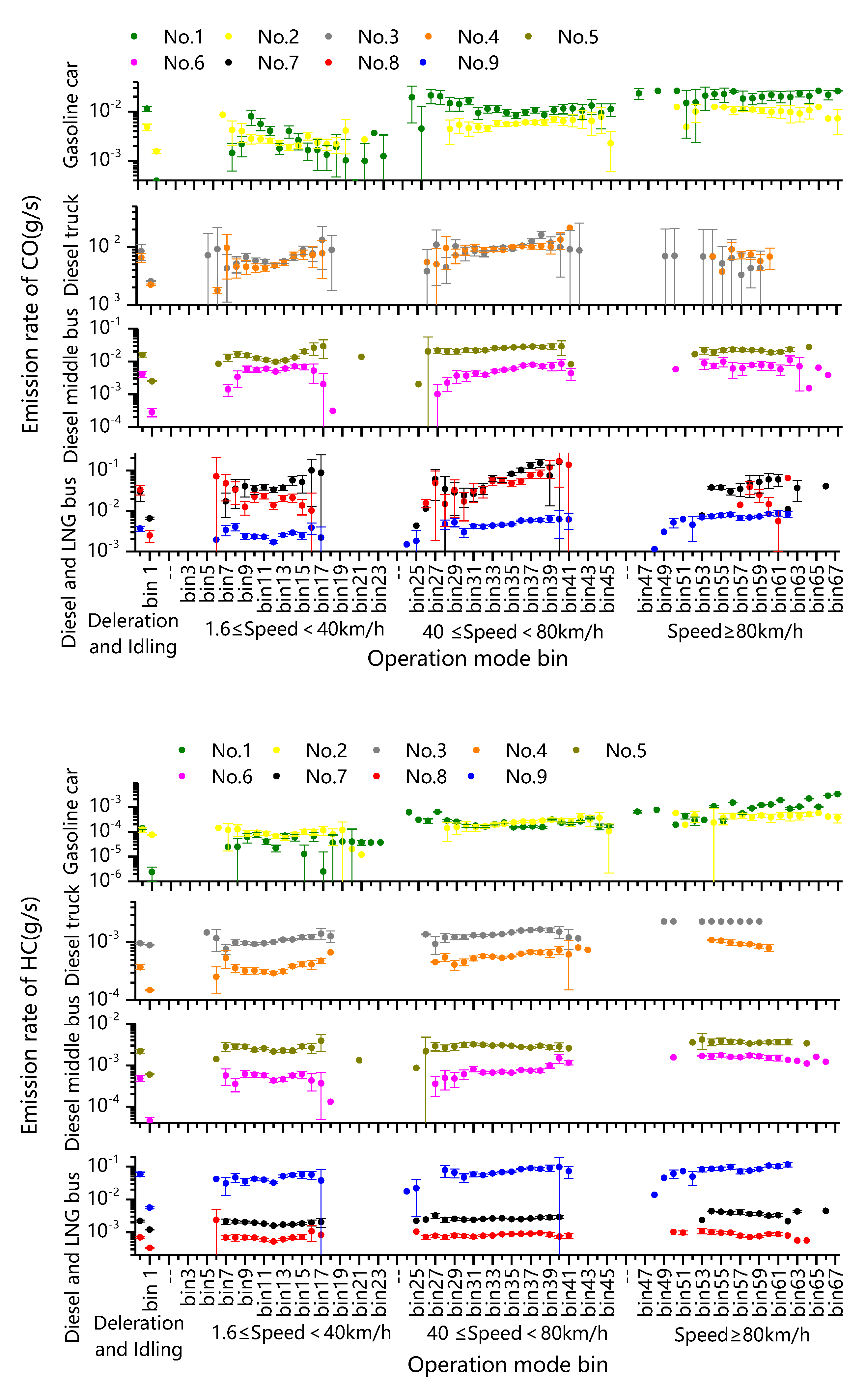
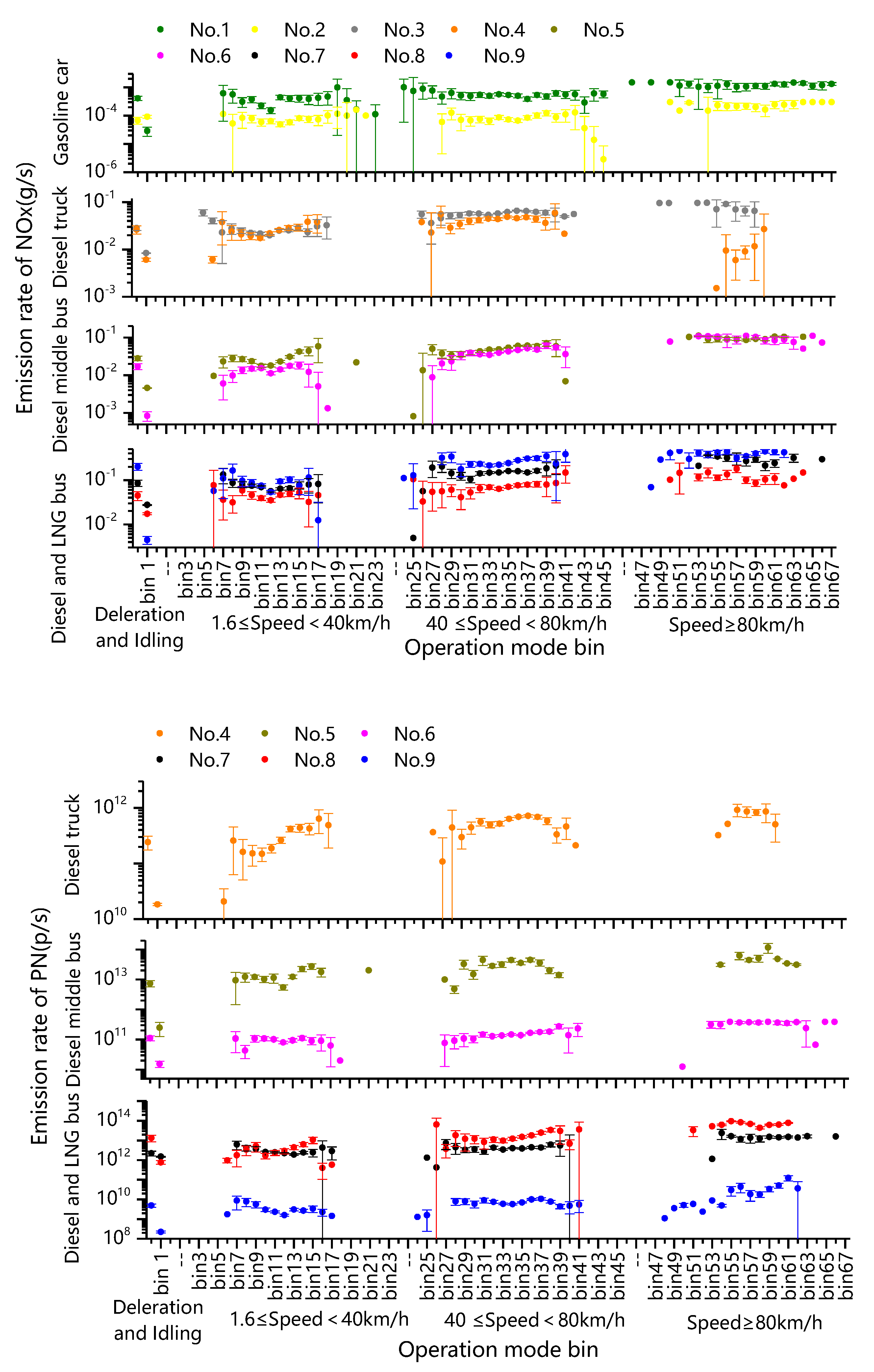
Appendix B
| Stage # | D50% (μm) | Di (μm) | Definition by Mode | Definition by PN | Definition by PM |
|---|---|---|---|---|---|
| 1 | 0.006 | 0.010 | Nucleation mode | PN0.01 | PM2.5 |
| 2 | 0.016 | 0.020 | Aitken mode | PN0.01–0.1 | |
| 3 | 0.030 | 0.040 | |||
| 4 | 0.054 | 0.070 | |||
| 5 | 0.094 | 0.120 | Accumulation mode | PN0.1–2 | |
| 6 | 0.150 | 0.190 | |||
| 7 | 0.250 | 0.310 | |||
| 8 | 0.380 | 0.480 | |||
| 9 | 0.600 | 0.750 | |||
| 10 | 0.940 | 1.230 | |||
| 11 | 1.620 | 2.000 | |||
| 12 | 2.460 | 2.990 | Coarse mode | PN2–8 | PM2.5–10 |
| 13 | 3.630 | 4.400 | |||
| 14 | 5.340 | 7.310 |
| Fuel Composition | Gasoline,92# | Diesel,0# | LNG |
|---|---|---|---|
| Density (20 °C, kg/m3) | 733.5 | 833.0 | 0.714 (Gas) |
| Vapor pressure (kPa) | 58.6 | NA | NA |
| 10% evaporation temperature (°C) | 59.5 | 205.2 | NA |
| 50% evaporation temperature (°C) | 100.0 | 252.0 | NA |
| 90% evaporation temperature (°C) | 163.5 | 330.0 | NA |
| Figure Octane number | 92.6 | NA | 130 |
| Cetane number | NA | 52.6 | <10 |
| Sulfur (mg/kg) | 6.3 | 6.1 | NA |
| Olefin (V/V, %) | 9.1 | NA | NA |
| Benzene (V/V, %) | 0.6 | NA | NA |
| Methane (V/V, %) | NA | NA | >99 |
| Aromatic hydrocarbon (V/V, %) | 23 | NA | NA |
| Fatty Acid Methyl Ester (V/V, %) | NA | <0.01 | NA |
| Oxygen (m/m, %) | 1.9 | NA | NA |
| Methyl alcohol (m/m, %) | 0.1 | NA | NA |
| PAHs (m/m, %) | NA | 2.7 | NA |
| Ash (m/m, %) | NA | 0.001 | NA |
| Undissolved substance (mg/100 mL) | NA | 0.9 | NA |
| Number | Length (km) | Proportion of Urban Areas (%) (V < 40 km/h) | Proportion of Suburbs (%) (40 ≤ V < 80 km/h) | Proportion of Express Ways (%) (V ≥ 80 km/h) | NV of VSP (kW/t) | AVG and NV of Speed (km/h) | Duration (s) |
|---|---|---|---|---|---|---|---|
| 1 | 39.72 | 19.66 | 70.45 | 9.89 | 1.34 (−52.55 to 36.50) | 35.37 (0 to 112.49) | 4042 |
| 2 | 49.39 | 24.56 | 69.41 | 6.03 | 1.18 (−47.67 to 26.22) | 38.56 (0 to 89.64) | 4610 |
| 3/1 | 66.42 | 18.70 | 80.28 | 1.02 | 1.36 (−38.67 to 17.82) | 37.01 (0 to 84.33) | 6459 |
| 3/2 | 42.06 | 21.89 | 78.11 | 0.00 | 1.09 (−38.64 to 20.97) | 32.65 (0 to 79.82) | 4637 |
| 4/1 | 62.35 | 17.88 | 78.11 | 4.01 | 1.61 (−37.43 to 16.22) | 43.06 (0 to 84.81) | 5212 |
| 4/2 | 42.07 | 20.05 | 75.15 | 4.80 | 1.25 (−25.64 to 21.13) | 39.86 (0 to 83.85) | 3799 |
| 5/1 | 43.19 | 20.34 | 73.69 | 5.97 | 1.23 (−21.66 to 19.76) | 38.83 (0 to 93.66) | 4004 |
| 5/2 | 43.29 | 18.17 | 74.37 | 7.45 | 1.39 (−38.12 to 18.63) | 39.45 (0 to 94.15) | 3950 |
| 6/1 | 41.77 | 20.92 | 73.70 | 5.38 | 1.35 (−103.76 to 18.63) | 37.64 (0 to 98.01) | 3994 |
| 6/2 | 46.31 | 21.32 | 78.68 | 0.00 | 1.41 (−22.19 to 16.53) | 42.68 (0 to 76.12) | 3905 |
| 7/1 | 38.96 | 27.66 | 66.48 | 5.86 | 0.99 (−17.91 to 21.42) | 33.79 (0 to 94.90) | 4150 |
| 7/2 | 46.58 | 26.45 | 71.20 | 2.35 | 1.08 (−23.11 to 17.00) | 32.51 (0 to 84.45) | 5157 |
| 8/1 | 39.74 | 23.04 | 70.33 | 6.63 | 1.50 (−26.79 to 18.55) | 38.95 (0 to 89.40) | 3672 |
| 8/2 | 27.83 | 29.10 | 53.35 | 17.55 | 1.19 (−25.36 to 20.19) | 33.04 (0 to 96.00) | 3031 |
| 9/1 | 38.83 | 24.54 | 66.03 | 9.43 | 0.69 (−18.15 to 15.81) | 19.75 (0 to 97.30) | 7079 |
| 9/2 | 45.50 | 18.62 | 70.09 | 11.29 | 1.59 (−22.81 to 16.15) | 42.40 (0 to 86.99) | 3862 |
| Deceleration | Bin0 (Acceleration < −1 m/s2) | ||
|---|---|---|---|
| Idling | Bin1 (0 ≤ Speed < 1.6 km/h, Acceleration = 0 m/s2) | ||
| VSP (kW/t) | Urban Cruising (0 ≤ Speed < 40 km/h, Acceleration ≠ 0 m/s2) | Suburb Cruising (40 ≤ Speed < 80 km/h) | Expressway Cruising (Speed ≥ 80 km/h) |
| (−∞,−18) | bin2 | bin24 | bin46 |
| [−18,−16) | bin3 | bin25 | bin47 |
| [−16,−14) | bin4 | bin26 | bin48 |
| [−14,−12) | bin5 | bin27 | bin49 |
| [−12,−10) | bin6 | bin28 | bin50 |
| [−10,−8) | bin7 | bin29 | bin51 |
| [−8,−6) | bin8 | bin30 | bin52 |
| [−6,−4) | bin9 | bin31 | bin53 |
| [−4,−2) | bin10 | bin32 | bin54 |
| [−2,0) | bin11 | bin33 | bin55 |
| [0,2) | bin12 | bin34 | bin56 |
| [2,4) | bin13 | bin35 | bin57 |
| [4,6) | bin14 | bin36 | bin58 |
| [6,8) | bin15 | bin37 | bin59 |
| [8,10) | bin16 | bin38 | bin60 |
| [10,12) | bin17 | bin39 | bin61 |
| [12,14) | bin18 | bin40 | bin62 |
| [14,16) | bin19 | bin41 | bin63 |
| [16,18) | bin20 | bin42 | bin64 |
| [18,20) | bin21 | bin43 | bin65 |
| [20,22) | bin22 | bin44 | bin66 |
| [22,+∞) | bin23 | bin45 | bin67 |
References
- Varella, R.A.; Giechaskiel, B.; Sousa, L.; Duarte, G. Comparison of Portable Emissions Measurement Systems (PEMS) with Laboratory Grade Equipment. Appl. Sci. 2018, 8, 1633. [Google Scholar] [CrossRef]
- Zhang, W.; Lu, J.; Xu, P.; Zhang, Y. Moving towards Sustainability: Road Grades and On-Road Emissions of Heavy-Duty Vehicles—A Case Study. Sustainability 2015, 7, 12644–12671. [Google Scholar] [CrossRef]
- Liu, Y.; Martinet, S.; Louis, C.; Pasquier, A.; Tassel, P.; Perret, P. Emission Characterization of In-Use Diesel and Gasoline Euro 4 to Euro 6 Passenger Cars Tested on Chassis Dynamometer Bench and Emission Model Assessment. Aerosol Air Qual. Res. 2017, 17, 2289–2299. [Google Scholar] [CrossRef]
- Nghiem, T.-D.; Nguyen, Y.-L.T.; Le, A.-T.; Bui, N.-D.; Pham, H.-T. Development of the specific emission factors for buses in Hanoi, Vietnam. Environ. Sci. Pollut. Res. 2019, 26, 24176–24189. [Google Scholar] [CrossRef] [PubMed]
- Wu, Y.; Zhang, S.; Hao, J.; Liu, H.; Wu, X.; Hu, J.; Walsh, M.P.; Wallington, T.J.; Zhang, K.M.; Stevanovic, S. On-road vehicle emissions and their control in China: A review and outlook. Sci. Total Environ. 2017, 574, 332–349. [Google Scholar] [CrossRef]
- Mishra, S.; Kushwaha, A.; Aggrawal, D.; Gupta, A. Comparative emission study by real-time congestion monitoring for stable pollution policy on temporal and meso-spatial regions in Delhi. J. Clean. Prod. 2019, 224, 465–478. [Google Scholar] [CrossRef]
- Cen, X.; Hong, K.L.; Li, L. A framework for estimating traffic emissions: The development of Passenger Car Emission Unit. Transp. Res. Part D 2016, 44, 78–92. [Google Scholar] [CrossRef]
- Cui, H.; Chen, W.; Dai, W.; Liu, H.; Wang, X.; He, K. Source apportionment of PM2.5 in Guangzhou combining observation data analysis and chemical transport model simulation. Atmos. Environ. 2015, 116, 262–271. [Google Scholar] [CrossRef]
- Wang, Y.; Li, L.; Chen, C.; Huang, H.; Feng, J.; Wang, S.; Wang, H.; Zhang, G.; Zhou, M.; Cheng, P. Source apportionment of fine particulate matter during autumn haze episodes in Shanghai, China. J. Geophys. Res.: Atmos. 2014, 119, 1903–1914. [Google Scholar] [CrossRef]
- Yang, F.; Tan, J.; Zhao, Q.; Du, Z.; He, K.; Ma, Y.; Duan, F.; Chen, G.; Zhao, Q. Characteristics of PM2.5 speciation in representative megacities and across China. Atmos. Chem. Phys. 2011, 11, 1025–1051. [Google Scholar] [CrossRef]
- Gu, X.; Yin, S.; Lu, X.; Zhang, H.; Wang, L.; Bai, L.; Wang, C.; Zhang, R.; Yuan, M. Recent development of a refined multiple air pollutant emission inventory of vehicles in the Central Plains of China. J. Environ. Sci. (Beijing, China) 2019, 84, 80–96. [Google Scholar] [CrossRef] [PubMed]
- Ji, D.; Cui, Y.; Li, L.; He, J.; Wang, L.; Zhang, H.; Wang, W.; Zhou, L.; Maenhaut, W.; Wen, T. Characterization and source identification of fine particulate matter in urban Beijing during the 2015 Spring Festival. Sci. Total Environ. 2018, 628–629, 430–440. [Google Scholar] [CrossRef] [PubMed]
- Geng, N.; Wang, Y.; Zhang, W.; Chen, C.; Zhang, R. PM2.5 in an industrial district of Zhengzhou, China: Chemical composition and source apportionment. Particuology 2013, 11, 99–109. [Google Scholar] [CrossRef]
- Cheng, Y.; Lee, S.; Gu, Z.; Ho, K.; Zhang, Y.; Huang, Y.; Chow, J.C. PM2.5 and PM10-2.5 chemical composition and source apportionment near a Hong Kong roadway. Particuology 2015, 18, 1–9. [Google Scholar] [CrossRef]
- Wang, P.; Cao, J.J.; Shen, Z.X.; Han, Y.M.; Lee, S.C.; Huang, Y.; Zhu, C.S.; Wang, Q.Y.; Xu, H.M.; Huang, R.J. Spatial and seasonal variations of PM2.5 mass and species during 2010 in Xi’an, China. Sci. Total Environ. 2015, 508, 477–487. [Google Scholar] [CrossRef]
- Wu, X.; Zhang, S.; Wu, Y.; Li, Z.; Zhou, Y.; Fu, L.; Hao, J. Real-world emissions and fuel consumption of diesel buses and trucks in Macao: From on-road measurement to policy implications. Atmos. Environ. 2015, 120, 393–403. [Google Scholar] [CrossRef]
- Khan, T.; Frey, H.C. Comparison of real-world and certification emission rates for light duty gasoline vehicles. Sci. Total Environ. 2018, 622–623, 790–800. [Google Scholar] [CrossRef]
- Mahesh, S.; Ramadurai, G.; Nagendra, S.M.S. Real-world emissions of gaseous pollutants from diesel passenger cars using portable emission measurement systems. Sustain. Cities Soc. 2018, 41, 104–113. [Google Scholar] [CrossRef]
- Sileghem, L.; Bosteels, D.; May, J.; Favre, C.; Verhelst, S. Analysis of vehicle emission measurements on the new WLTC, the NEDC and the CADC. Transp. Res. Part D 2014, 32, 70–85. [Google Scholar] [CrossRef]
- Degraeuwe, B.; Weiss, M. Does the New European Driving Cycle (NEDC) really fail to capture the NOx emissions of diesel cars in Europe? Environ. Pollut. (Oxford, U.K.) 2017, 222, 234–241. [Google Scholar] [CrossRef]
- Fontaras, G.; Franco, V.; Dilara, P.; Martini, G.; Manfredi, U. Development and review of Euro 5 passenger car emission factors based on experimental results over various driving cycles. Sci. Total Environ. 2014, 468–469, 1034–1042. [Google Scholar] [CrossRef] [PubMed]
- Fu, M.; Ge, Y.; Wang, X.; Tan, J.; Yu, L.; Liang, B. NOx emissions from Euro IV busses with SCR systems associated with urban, suburban and freeway driving patterns. Sci. Total Environ. 2013, 452–453, 222–226. [Google Scholar] [CrossRef] [PubMed]
- Pathak, S.K.; Sood, V.; Singh, Y.; Channiwala, S.A. Real world vehicle emissions: Their correlation with driving parameters. Transp. Res. Part D 2016, 44, 157–176. [Google Scholar] [CrossRef]
- Luján, J.M.; Bermúdez, V.; Dolz, V.; Monsalve-Serrano, J. An assessment of the real-world driving gaseous emissions from a Euro 6 light-duty diesel vehicle using a portable emissions measurement system (PEMS). Atmos. Environ. 2018, 174, 112–121. [Google Scholar] [CrossRef]
- Arun, N.H.; Mahesh, S.; Ramadurai, G.; Nagendra, S.M.S. Development of driving cycles for passenger cars and motorcycles in Chennai, India. Sustain. Cities Soc. 2017, 32, 508–512. [Google Scholar] [CrossRef]
- Yao, Z.; Cao, X.; Shen, X.; Zhang, Y.; Wang, X.; He, K. On-road emission characteristics of CNG-fueled bi-fuel taxis. Atmos. Environ. 2014, 94, 198–204. [Google Scholar] [CrossRef]
- Cicero-Fernândez, P.; Long, J.R.; Winer, A.M. Effects of grades and other loads on on-road emissions of hydrocarbons and carbon monoxide. J. Air Waste Manag. Assoc. 1997, 47, 898–904. [Google Scholar] [CrossRef]
- Wyatt, D.W.; Li, H.; Tate, J.E. The impact of road grade on carbon dioxide (CO2) emission of a passenger vehicle in real-world driving. Transp. Res. Part D 2014, 32, 160–170. [Google Scholar] [CrossRef]
- Cha, J.; Lee, J.; Chon, M.S. Evaluation of real driving emissions for Euro 6 light-duty diesel vehicles equipped with LNT and SCR on domestic sales in Korea. Atmos. Environ. 2018, 196, 133–142. [Google Scholar] [CrossRef]
- Liu, Z.; Ge, Y.; Johnson, K.C.; Shah, A.N.; Tan, J.; Wang, C.; Yu, L. Real-world operation conditions and on-road emissions of Beijing diesel buses measured by using portable emission measurement system and electric low-pressure impactor. Sci. Total Environ. 2011, 409, 1476–1480. [Google Scholar] [CrossRef]
- Cheng, H.; Lou, D.; Hu, Z.; Qian, F.; Chen, Y.; Chen, C.; Tan, P.; Di, Y. A PEMS study of the emissions of gaseous pollutants and ultrafine particles from gasoline- and diesel-fueled vehicles. Atmos. Environ. 2013, 77, 703–710. [Google Scholar] [CrossRef]
- National Standard of the People’s Republic of China. Limits and Measurement Methods for Emissions from Diesel Fuelled Heavy-Duty Vehicles (CHINA VI); Ministry of Ecology and Environment of the People’s Republic of China: Beijing, China; State Administration for Market Supervision and Administration of the People’s Republic of China: Beijing, China, 2018; Volume GB 17691-2018. [Google Scholar]
- Frey, H.C.; Zhang, K.; Rouphail, N.M. Vehicle-Specific Emissions Modeling Based upon on-Road Measurements. Environ. Sci. Technol. 2010, 44, 3594–3600. [Google Scholar] [CrossRef]
- Liu, J.; Ge, Y.; Wang, X.; Hao, L.; Tan, J.; Peng, Z.; Zhang, C.; Gong, H.; Huang, Y. On-board measurement of particle numbers and their size distribution from a light-duty diesel vehicle: Influences of VSP and altitude. J. Environ. Sci. (Beijing, China) 2017, 57, 238–248. [Google Scholar] [CrossRef]
- Sandhu, G.; Frey, H. Effects of Errors on Vehicle Emission Rates from Portable Emissions Measurement Systems. Transp. Res. Rec. 2013, 2340, 10–19. [Google Scholar] [CrossRef]
- Zhang, S.; Wu, Y.; Hu, J.; Huang, R.; Zhou, Y.; Bao, X.; Fu, L.; Hao, J. Can Euro V heavy-duty diesel engines, diesel hybrid and alternative fuel technologies mitigate NOx emissions? New evidence from on-road tests of buses in China. Appl. Energy 2014, 132, 118–126. [Google Scholar] [CrossRef]
- Beydoun, M.; Guldmann, J.M. Vehicle characteristics and emissions: Logit and regression analyses of I/M data from Massachusetts, Maryland, and Illinois. Transp. Res. Part D 2006, 11, 59–76. [Google Scholar] [CrossRef]
- Chiang, H.L.; Tsai, J.H.; Yao, Y.C.; Ho, W.Y. Deterioration of gasoline vehicle emissions and effectiveness of tune-up for high-polluted vehicles. Transp. Res. Part D 2008, 13, 47–53. [Google Scholar] [CrossRef]
- Amanatidis, S.; Ntziachristos, L.; Giechaskiel, B.; Bergmann, A.; Samaras, Z. Impact of selective catalytic reduction on exhaust particle formation over excess ammonia events. Environ. Sci. Technol. 2014, 48, 11527–11534. [Google Scholar] [CrossRef]
- Wen, Y.; Wang, H.; Larson, T.; Kelp, M.; Zhang, S.; Wu, Y.; Marshallb, J.D. On-highway vehicle emission factors, and spatial patterns, based on mobile monitoring and absolute principal component score. Sci. Total Environ. 2019, 676, 242–251. [Google Scholar] [CrossRef]
- Zhang, C.H.; Song, J.T. Experimental study of co-combustion ratio on fuel consumption and emissions of NG–diesel dual-fuel heavy-duty engine equipped with a common rail injection system. J. Energy Inst. 2016, 89, 578–585. [Google Scholar] [CrossRef]
- Meng, X.; Tian, H.; Zhou, Y.; Tian, J.; Long, W.; Bi, M. Comparative study of pilot fuel property and intake air boost on combustion and performance in the CNG dual-fuel engine. Fuel 2019, 256, 1–8. [Google Scholar] [CrossRef]
- Lather, R.S.; Das, L.M. Performance and emission assessment of a multi-cylinder S.I engine using CNG & HCNG as fuels. Int. J. Hydrog. Energy 2019, 44, 21181–21192. [Google Scholar] [CrossRef]
- Cheng, H.; Tao, S.; Lou, S.; Hu, Q.; Zhou, L. Evaluation of emission factors for light-duty gasoline vehicles based on chassis dynamometer and tunnel studies in Shanghai, China. Atmos. Environ. 2017, 169, 193–203. [Google Scholar] [CrossRef]
- Huo, H.; Yao, Z.; Zhang, Y.; Shen, X.; Zhang, Q.; Ding, Y.; He, K. On-board measurements of emissions from light-duty gasoline vehicles in three mega-cities of China. Atmos. Environ. 2012, 49, 371–377. [Google Scholar] [CrossRef]
- Gao, J.H.; Wei, L.I.; Gao, J.D.; Liu, S.X.; Qin, K.J. Characteristics of particulate emissions from gasoline vehicles. J. Jilin Univ. 2010, 40, 947–952. [Google Scholar] [CrossRef]
- Wang, M.; Liu, X.; Feng, X.; Cao, H.; Guo, D. An Investigation into the Emission of In-Use Light Gasoline Vehicles in Beijing. Automot. Eng. 2014, 36, 74–76. [Google Scholar] [CrossRef]
- Zheng, X.; Wu, Y.; Zhang, S.; He, L.; Hao, J. Evaluating real-world emissions of light-duty gasoline vehicles with deactivated three-way catalyst converters. Atmos. Pollut. Res. 2017, 9, 126–132. [Google Scholar] [CrossRef]
- Wang, A.; Yun, S.; Tan, J.; Fu, M.; Naeem, A. On-road pollutant emission and fuel consumption characteristics of buses in Beijing. J. Environ. Sci. (Beijing, China) 2011, 23, 419–426. [Google Scholar] [CrossRef]
- Chong, H.S.; Park, Y.; Kwon, S.; Hong, Y. Analysis of real driving gaseous emissions from light-duty diesel vehicles. Transp. Res. Part D 2018, 65, 485–499. [Google Scholar] [CrossRef]
- Kosmadakis, G.M.; Rakopoulos, C.D. Computational fluid dynamics investigation of alternative nitric oxide emission mechanisms in a hydrogen-fueled spark-ignition engine. Int. J. Hydrog. Energy 2014, 39, 11774–11791. [Google Scholar] [CrossRef]
- Derrouiche, S.; Bianchi, D. Modifications of the elementary steps involved in the O2-oxidation of the adsorbed CO species over Pt/Al2O3 by co-adsorbed NO species. J. Catal. 2006, 242, 172–183. [Google Scholar] [CrossRef]
- Zhu, G.; Liu, J.; Fu, J.; Xua, Z.; Guo, Q.; Zhao, H. Experimental study on combustion and emission characteristics of turbocharged gasoline direct injection (GDI) engine under cold start new European driving cycle (NEDC). Fuel 2018, 215, 272–284. [Google Scholar] [CrossRef]
- Park, C.; Kim, C.; Lee, S.; Lee, S.; Lee, J. Comparative evaluation of performance and emissions of CNG engine for heavy-duty vehicles fueled with various caloric natural gases. Energy (Oxford, U.K.) 2019, 174, 1–9. [Google Scholar] [CrossRef]
- Li, W.; Liu, Z.; Wang, Z.; Dou, H.; Wang, C.; Li, J. Experimental and theoretical analysis of effects of equivalence ratio on mixture properties, combustion, thermal efficiency and exhaust emissions of a pilot-ignited NG engine at low loads. Fuel 2016, 171, 125–135. [Google Scholar] [CrossRef]
- Wei, L.; Yao, C.; Wang, Q.; Wang, P.; Han, G. Combustion and emission characteristics of a turbocharged diesel engine using high premixed ratio of methanol and diesel fuel. Fuel 2015, 140, 156–163. [Google Scholar] [CrossRef]
- Grigoratos, T.; Fontaras, G.; Giechaskiel, B.; Zacharof, N. Real world emissions performance of heavy-duty Euro VI diesel vehicles. Atmos. Environ. 2019, 201, 348–359. [Google Scholar] [CrossRef]
- Sakthivel, P.; Subramanian, K.A.; Mathai, R. Comparative studies on combustion, performance and emission characteristics of a two-wheeler with gasoline and 30% ethanol-gasoline blend using chassis dynamometer. Appl. Therm. Eng. 2019, 146, 726–737. [Google Scholar] [CrossRef]
- Fleischman, R.; Amiel, R.; Czerwinski, J.; Mayer, A.; Tartakovsky, L. Busses retrofitting with diesel particle filters: Real-world fuel economy and roadworthiness test considerations. J. Environ. Sci. (Beijing, China) 2017, 67, 1–14. [Google Scholar] [CrossRef]
- Misra, C.; Ruehl, C.; Collins, J.; Chernich, D.; Herner, J. In-Use NOx Emissions from Diesel and Liquefied Natural Gas Refuse Trucks Equipped with SCR and TWC, Respectively. Environ. Sci. Technol. 2017, 51, 6981–6989. [Google Scholar] [CrossRef]
- Wang, Z.; Zhao, Z.; Wang, D.; Tan, M.; Han, Y.; Liu, Z.; Dou, H. Impact of pilot diesel ignition mode on combustion and emissions characteristics of a diesel/natural gas dual fuel heavy-duty engine. Fuel 2016, 167, 248–256. [Google Scholar] [CrossRef]
- Jia, F.; Meng, Z.; Jian, L.; Pu, Y.; Du, Y.; Li, J.; Jin, Z.; Chao, C.; Chase, G.G. The influence of ash on soot deposition and regeneration processes in diesel particular filter. Appl. Therm. Eng. 2017, 124, 633–640. [Google Scholar] [CrossRef]
- Tandon, P.; Heibel, A.; Whitmore, J.; Kekre, N.; Chithapragada, K. Measurement and prediction of filtration efficiency evolution of soot loaded diesel particulate filters. Chem. Eng. Sci. 2010, 65, 4751–4760. [Google Scholar] [CrossRef]
- Zhao, H.; Ge, Y.; Zhang, T.; Zhang, J.; Tan, J.; Zhang, H. Unregulated emissions from diesel engine with particulate filter using Fe-based fuel borne catalyst. J. Environ. Sci. (Beijing, China) 2014, 26, 2027–2033. [Google Scholar] [CrossRef] [PubMed]
- Wu, B.Y.; Zhan, Q.; Zhang, S.K.; Nie, X.K.; Li, Y.H.; Su, W. Effect of heavy-duty diesel engine operating parameters on particle number and size distribution at low speed condition. Int. J. Automot. Technol. 2018, 19, 623–633. [Google Scholar] [CrossRef]
- Lee, S.; Cho, Y.; Song, M.; Kim, H.; Park, J.; Baik, D. Experimental study on the characteristics of nano-particle emissions from a heavy-duty diesel engine using a urea-SCR system. Int. J. Automot. Technol. 2012, 13, 355–363. [Google Scholar] [CrossRef]
- Herner, J.D.; Hu, S.; Robertson, W.H.; Tao, H.; Collins, J.F.; Dwyer, H.; Ayala, A.A. Effect of Advanced Aftertreatment for PM and NOx Control on Heavy-Duty Diesel Truck Emissions. Environ. Sci. Technol. 2009, 43, 5928–5933. [Google Scholar] [CrossRef]
- Herner, J.D.; Hu, S.; Robertson, W.H.; Tao, H.; Chang, M.C.O.; Rieger, P.; Ayala, A. Effect of Advanced Aftertreatment for PM and NOx Reduction on Heavy-Duty Diesel Engine Ultrafine Particle Emissions. Environ. Sci. Technol. 2011, 45, 2413–2419. [Google Scholar] [CrossRef]
- Biswas, S.; Verma, H.V.; Herner, J.D.; Robertson, W.H.; Ayala, A.; Sioutas, C. Physical properties of particulate matter (PM) from late model heavy-duty diesel vehicles operating with advanced PM and NOx emission control technologies. Atmos. Environ. 2008, 42, 5622–5634. [Google Scholar] [CrossRef]
- Noone, K. Atmospheric Chemistry and Physics: From Air Pollution to Climate Change, by John H. Seinfeld and Spyros N. Pandis. Environ. Sci. Policy Sustain. Dev. 1998, 40, 26. [Google Scholar] [CrossRef]
- Yu, L. Research of Combustion and Emission Characteristics of Heavy-duty Diesel Engine at Different Altitudes; Beijing Institute of Technology Beijing: Beijing, China, 2014. [Google Scholar]
- Wong, C.P.; Leung, T.L.C.W. Characterisation of diesel exhaust particle number and size distributions using mini-dilution tunnel and ejector-diluter measurement techniques. Atmos. Environ. 2003, 37, 4435–4446. [Google Scholar] [CrossRef]
- Giechaskiel, B.; Ntziachristos, L.; Samaras, Z.; Scheer, V.; Casati, R.; Vogt, R. Formation potential of vehicle exhaust nucleation mode particles on-road and in the laboratory. Atmos. Environ. 2005, 39, 3191–3198. [Google Scholar] [CrossRef]
- Rönkkö, T.; Virtanen, A.; Vaaraslahti, K.; Keskinen, J.; Pirjola, L.; Lappi, M. Effect of dilution conditions and driving parameters on nucleation mode particles in diesel exhaust: Laboratory and on-road study. Atmos. Environ. 2006, 40, 2893–2901. [Google Scholar] [CrossRef]
- Sakurai, H.; Tobias, H.J.; Park, K.; Zarling, D.; Docherty, K.S.; Kittelson, D.B.; Mcmurry, P.H.; Ziemann, P.J. On-line measurements of diesel nanoparticle composition and volatility. Atmos. Environ. 2003, 37, 1199–1210. [Google Scholar] [CrossRef]
- Zhang, Y.; Lou, D.; Tan, P.; Hu, Z. Experimental study on the particulate matter and nitrogenous compounds from diesel engine retrofitted with DOC+CDPF+SCR. Atmos. Environ. 2018, 177, 45–53. [Google Scholar] [CrossRef]
- Järvinen, A.; Aitomaa, M.; Rostedt, A.; Keskinen, J.; Yli-Ojanperä, J. Calibration of the new electrical low pressure impactor (ELPI+). J. Aerosol Sci. 2014, 69, 150–159. [Google Scholar] [CrossRef]
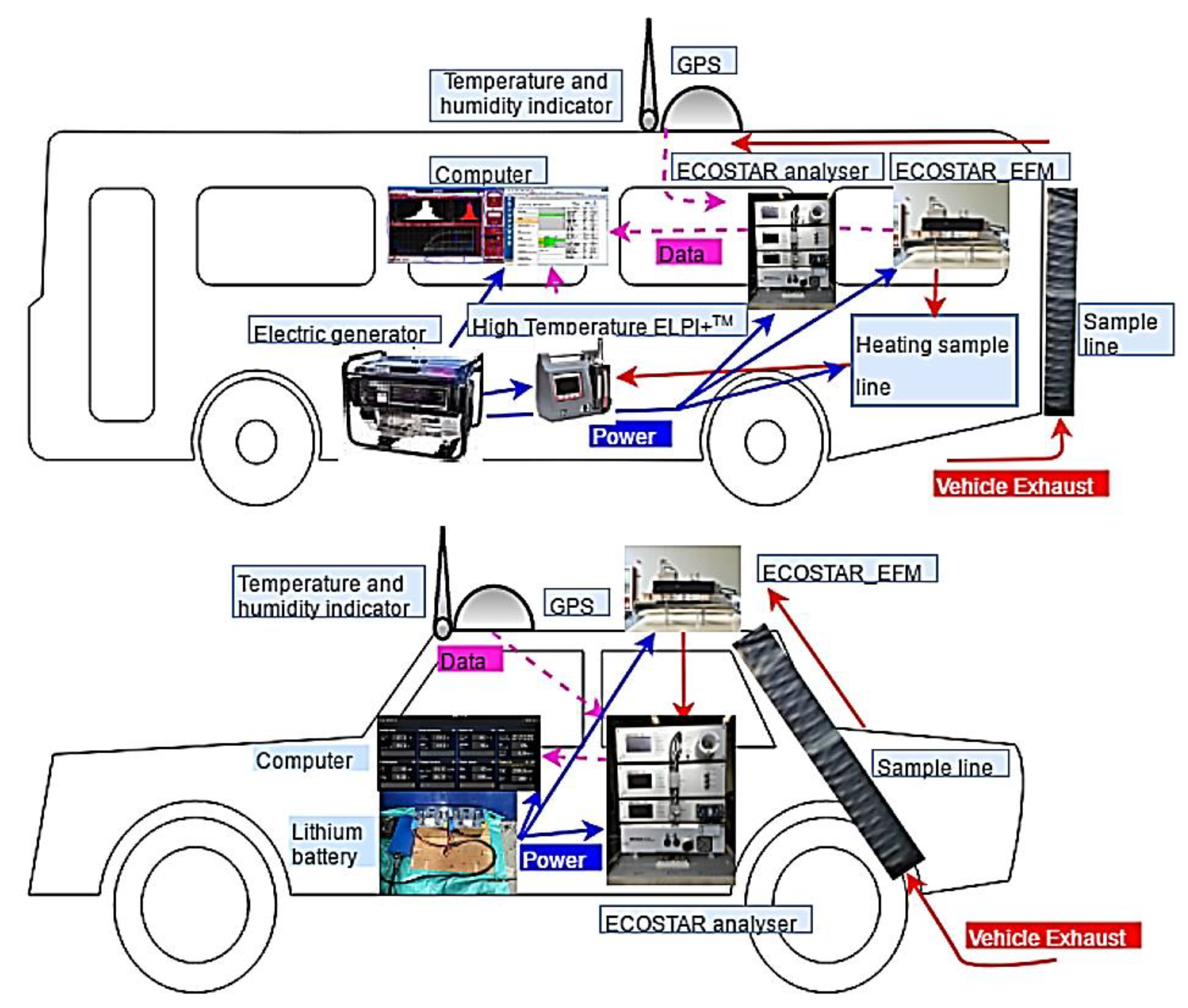
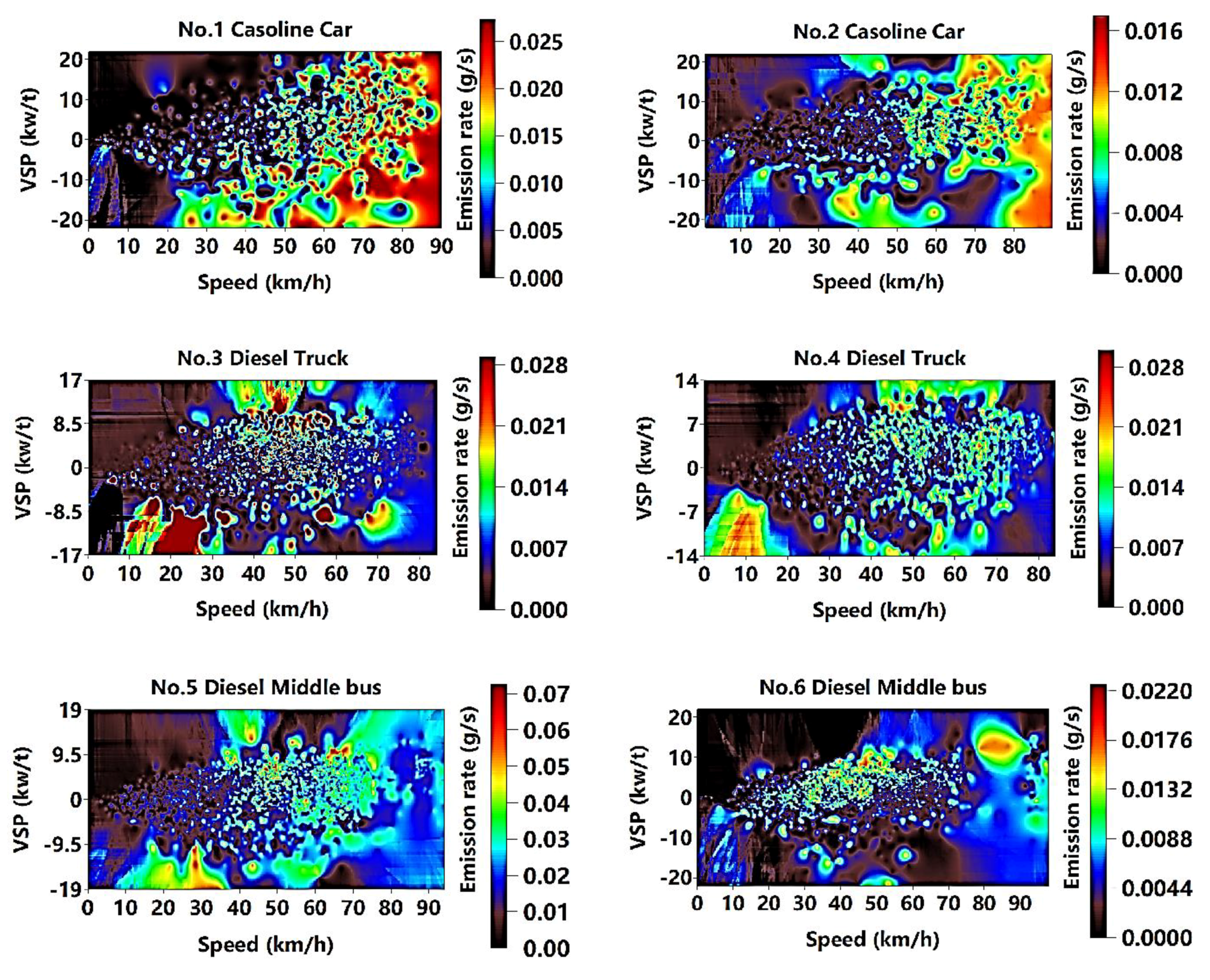
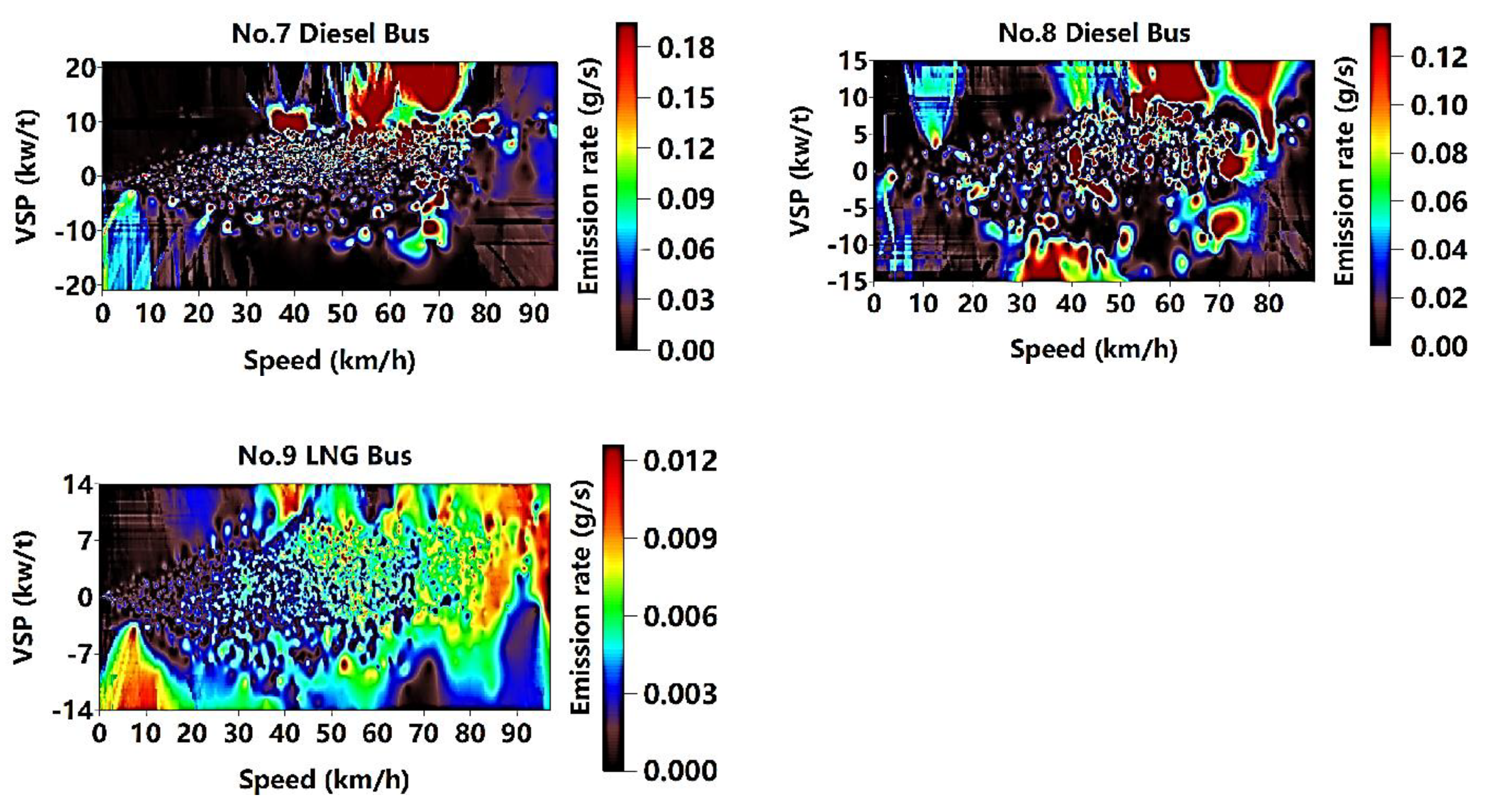
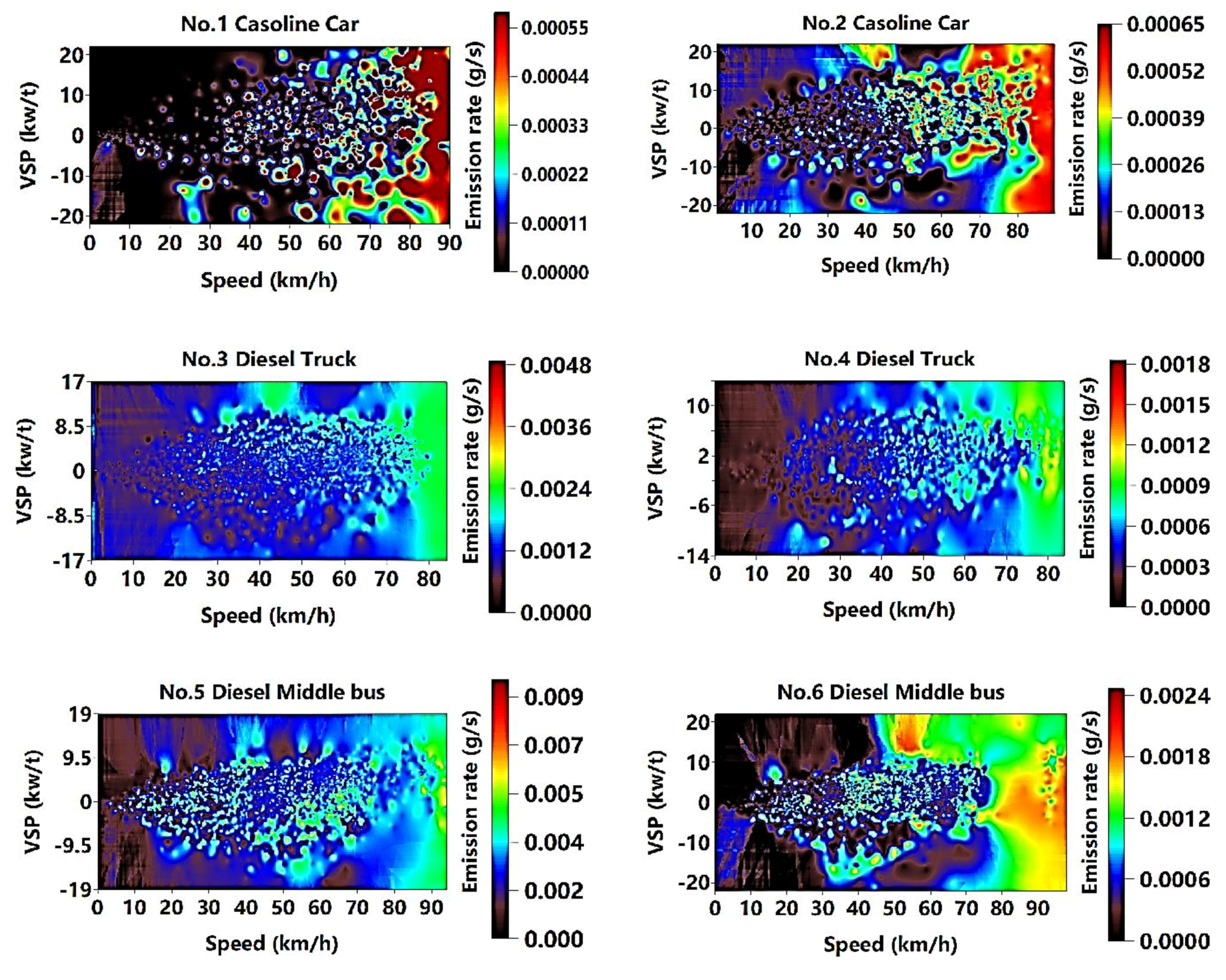
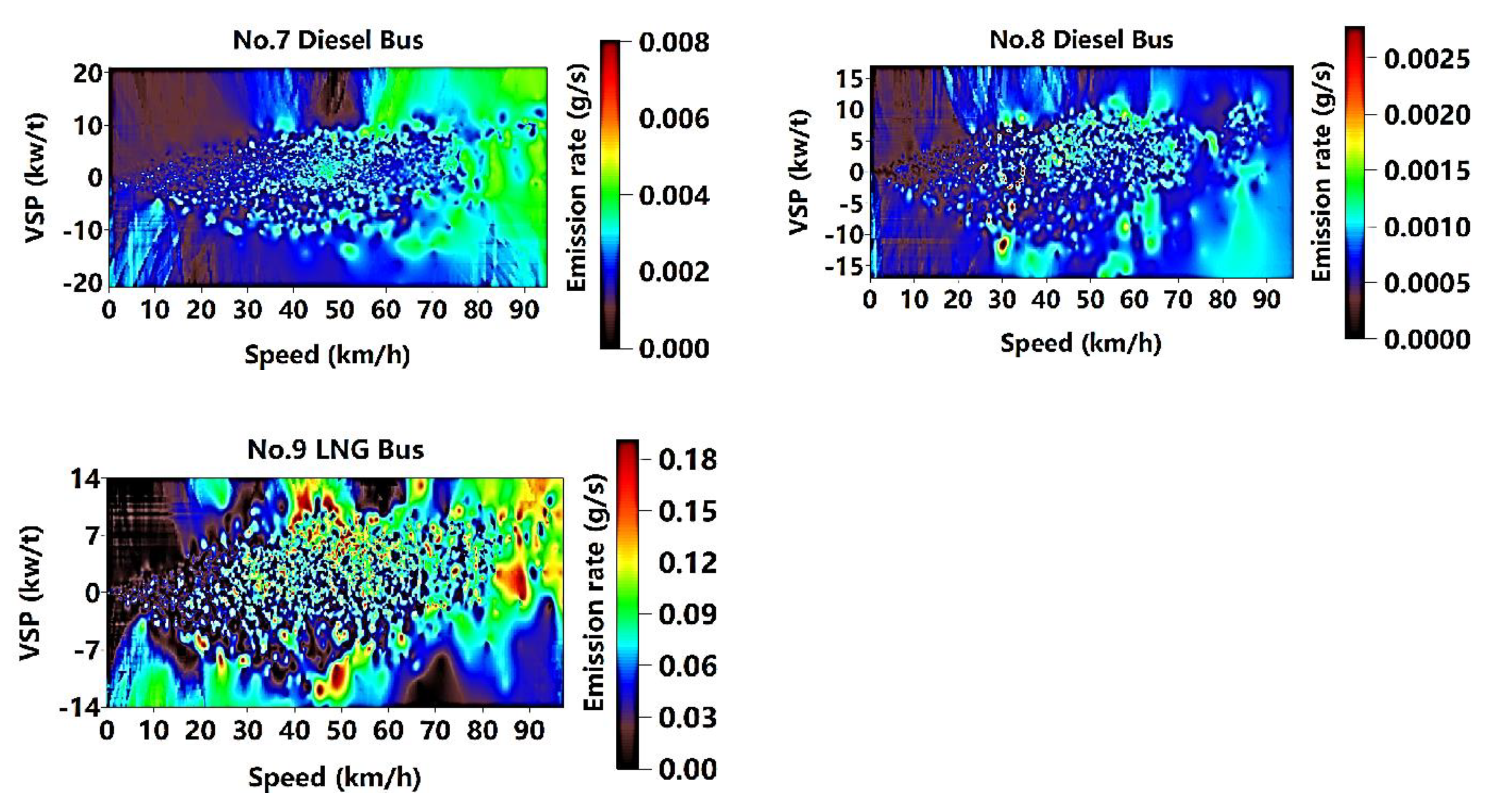
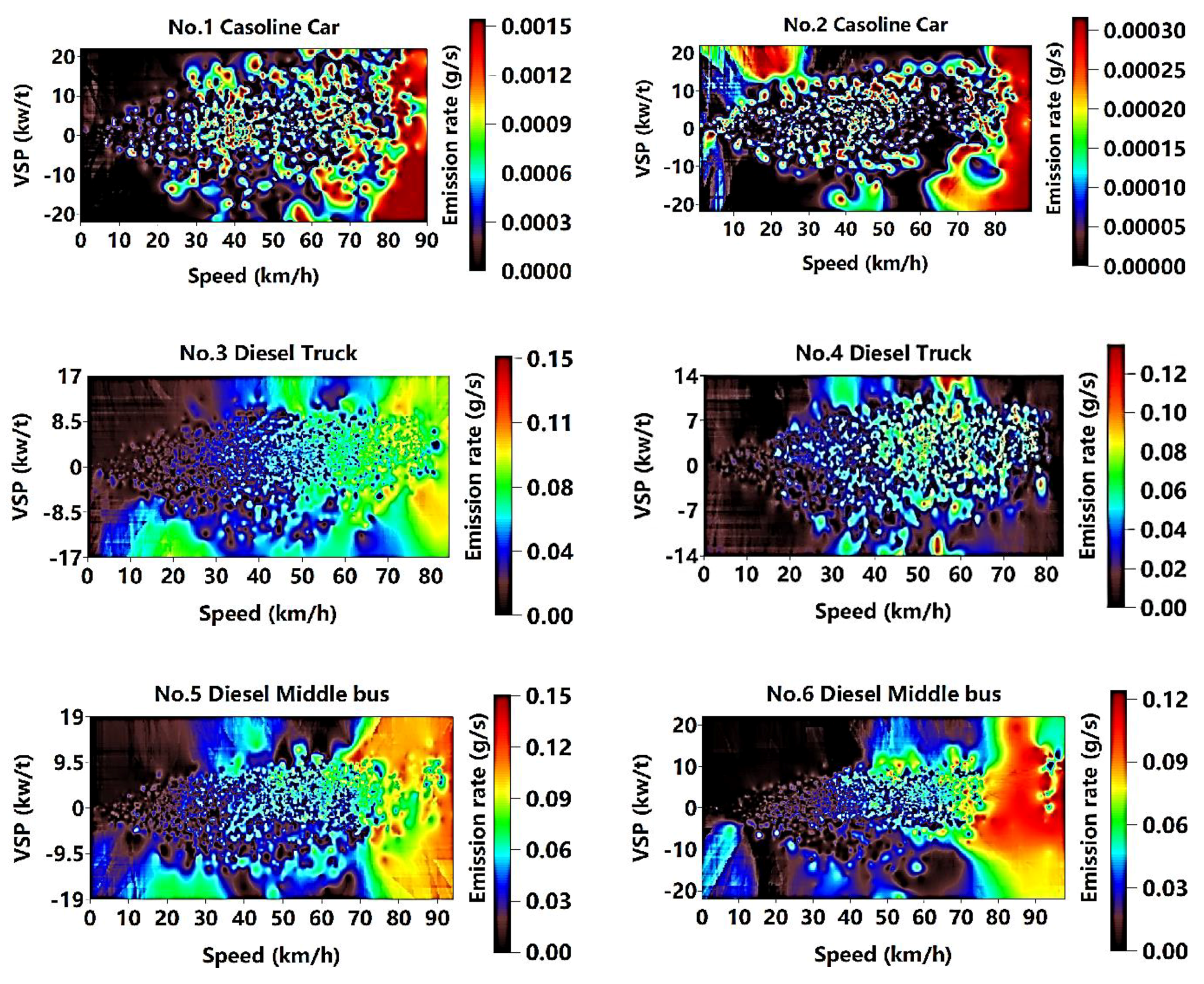
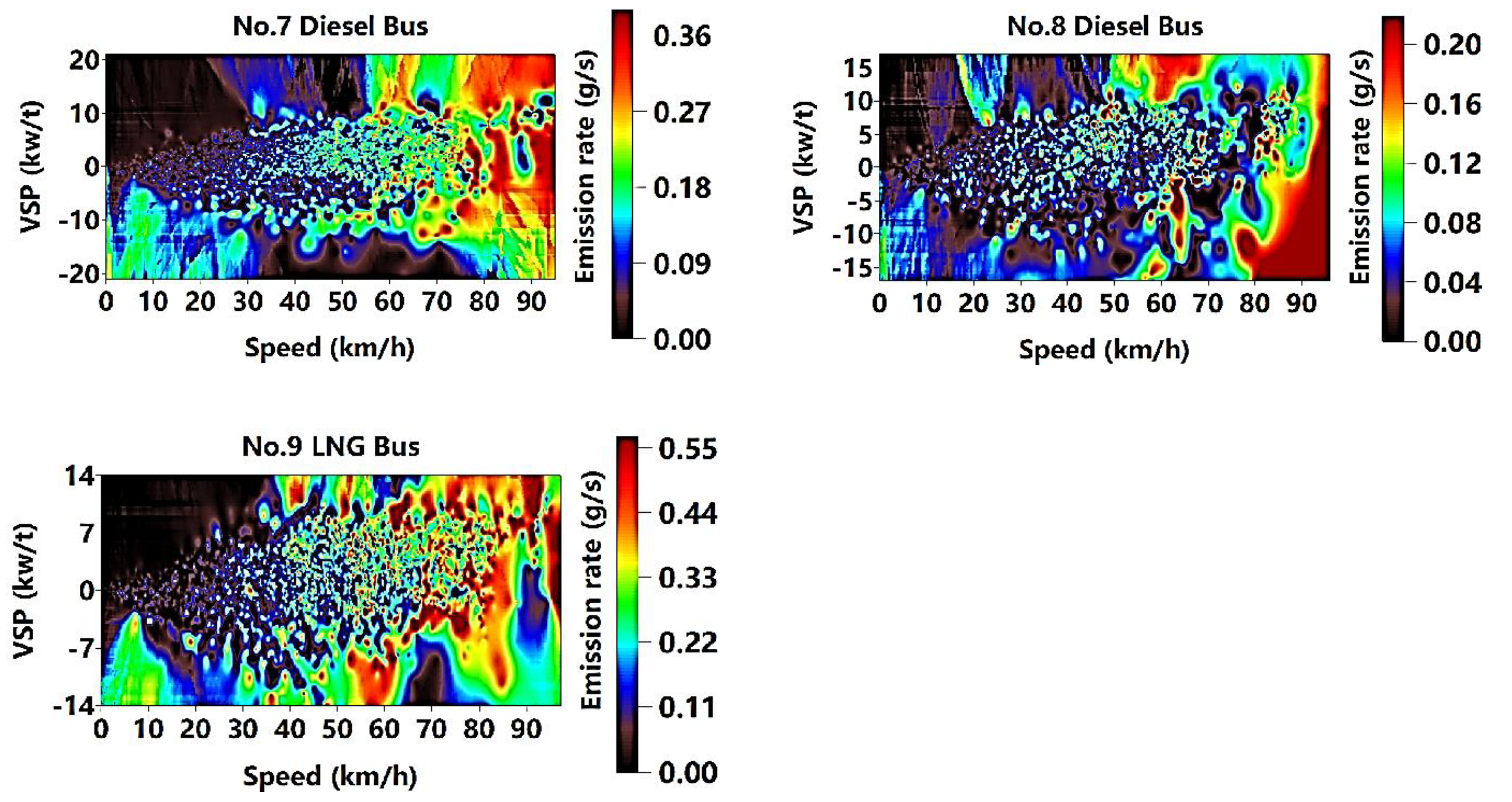
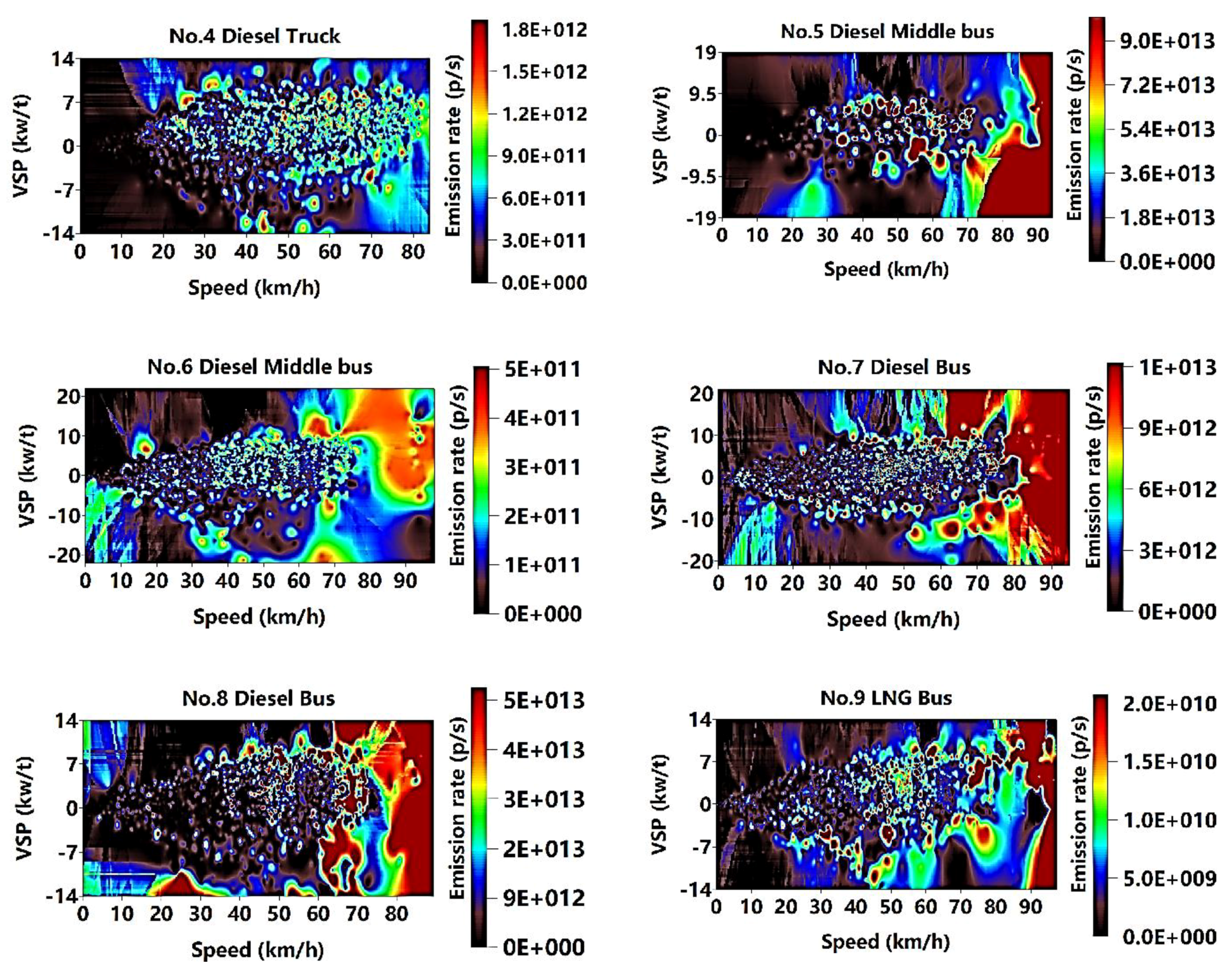
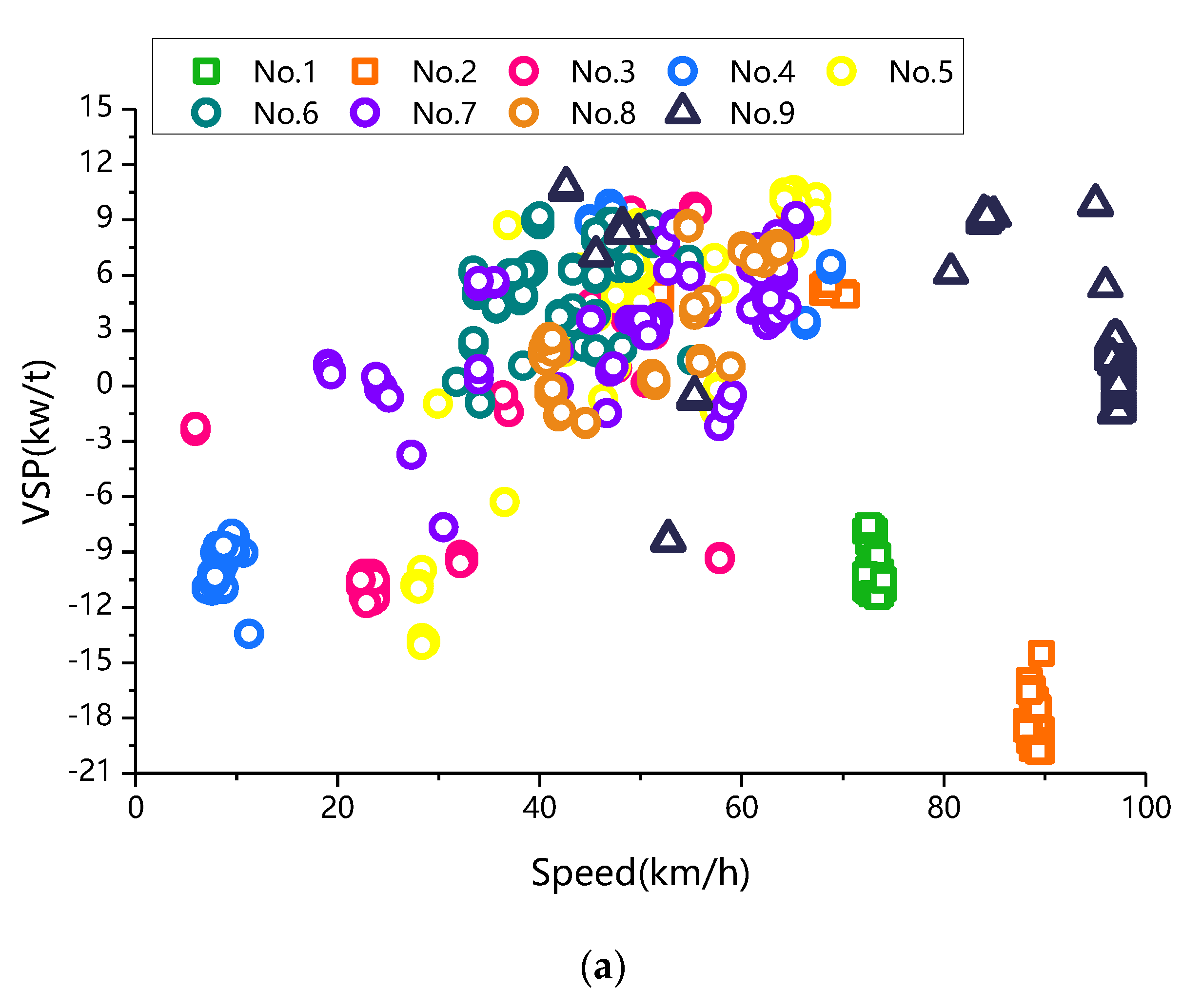

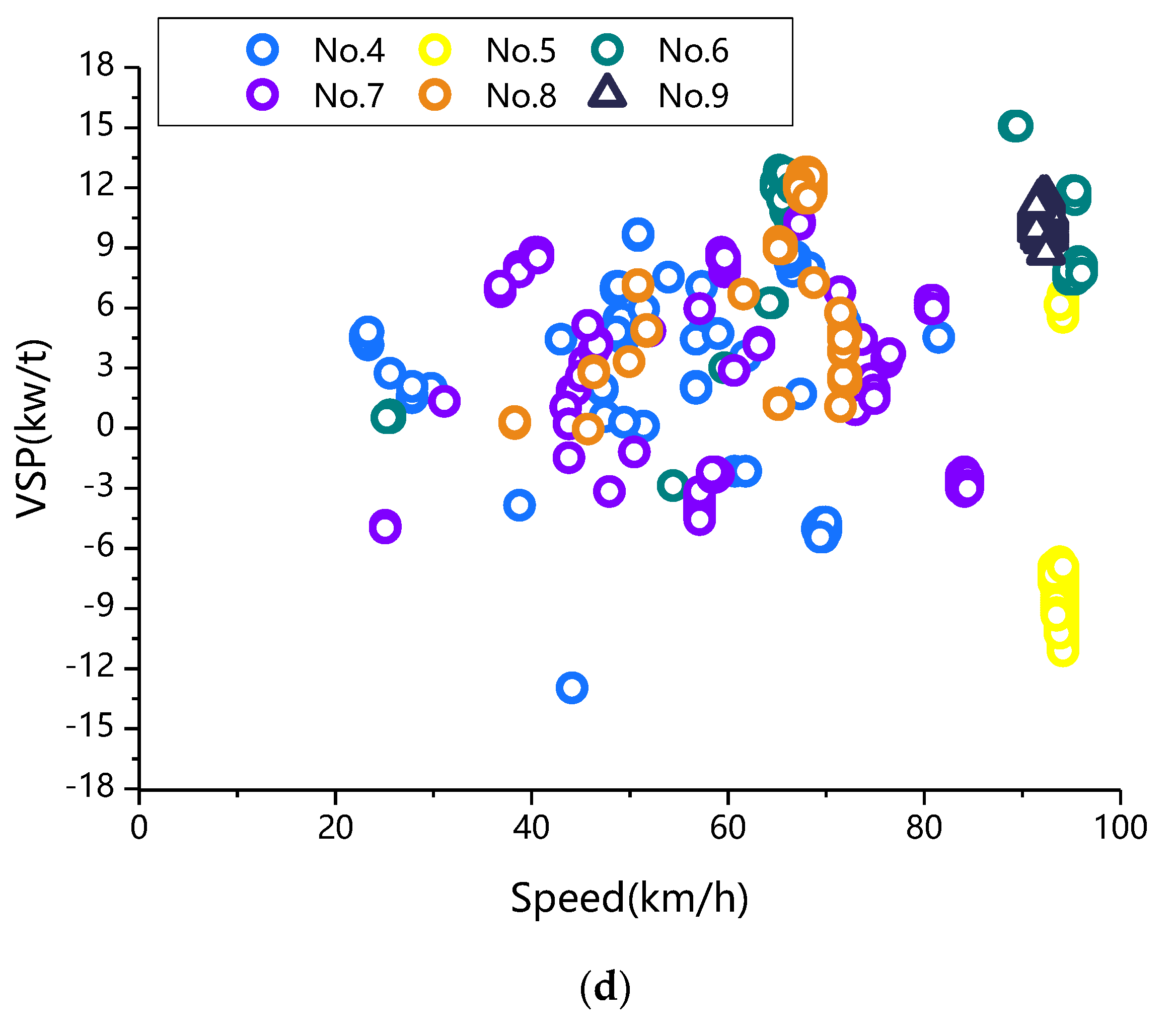
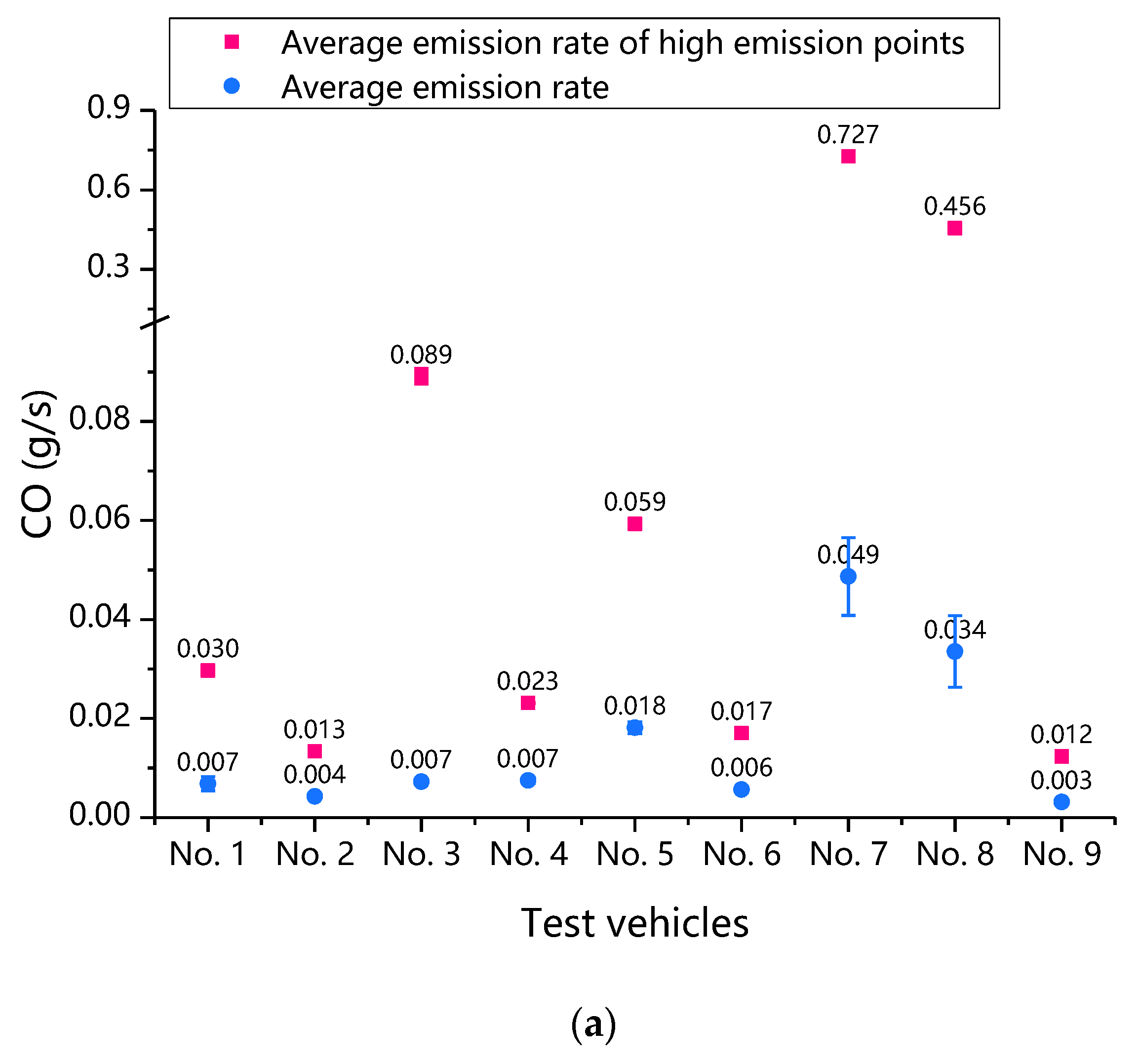
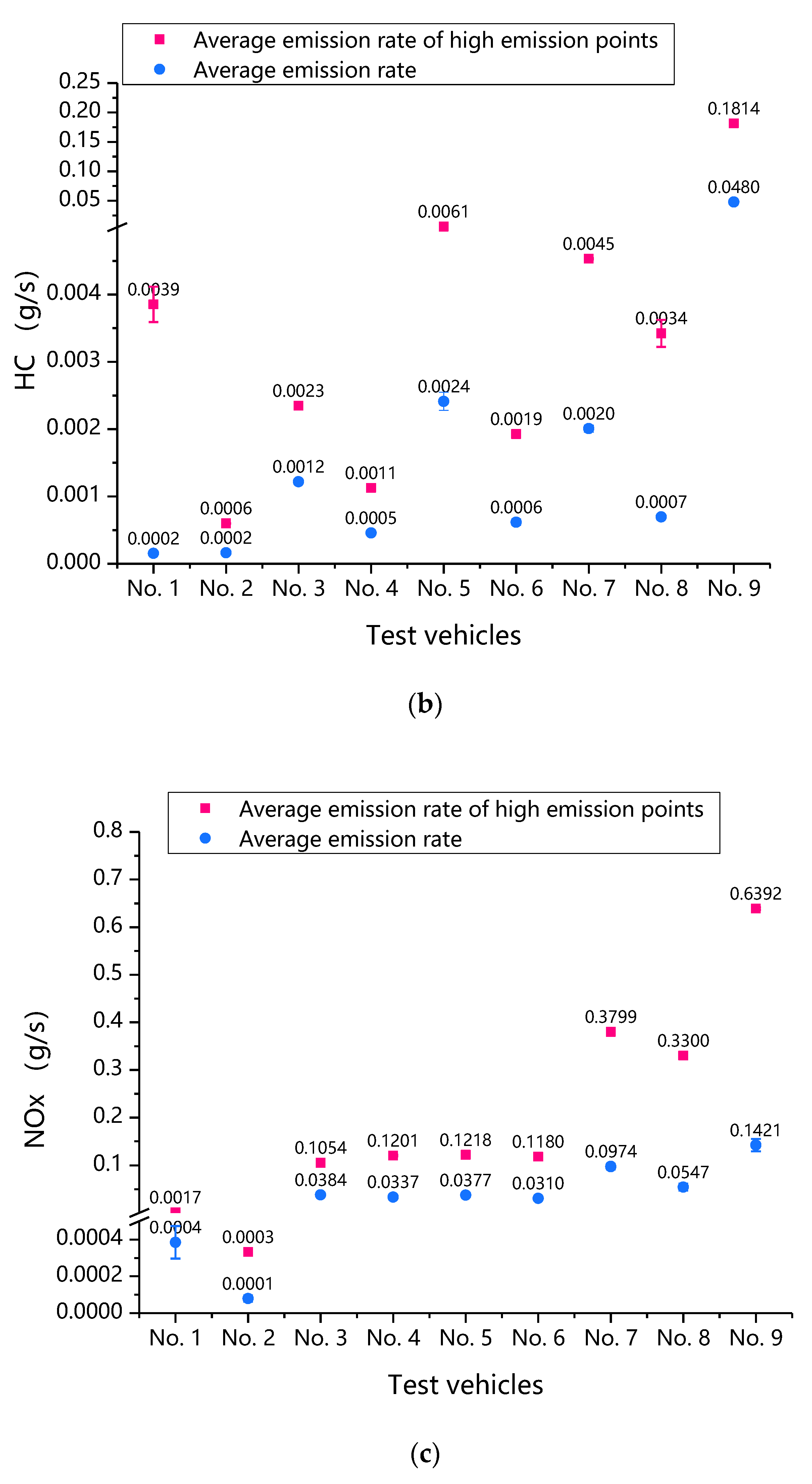
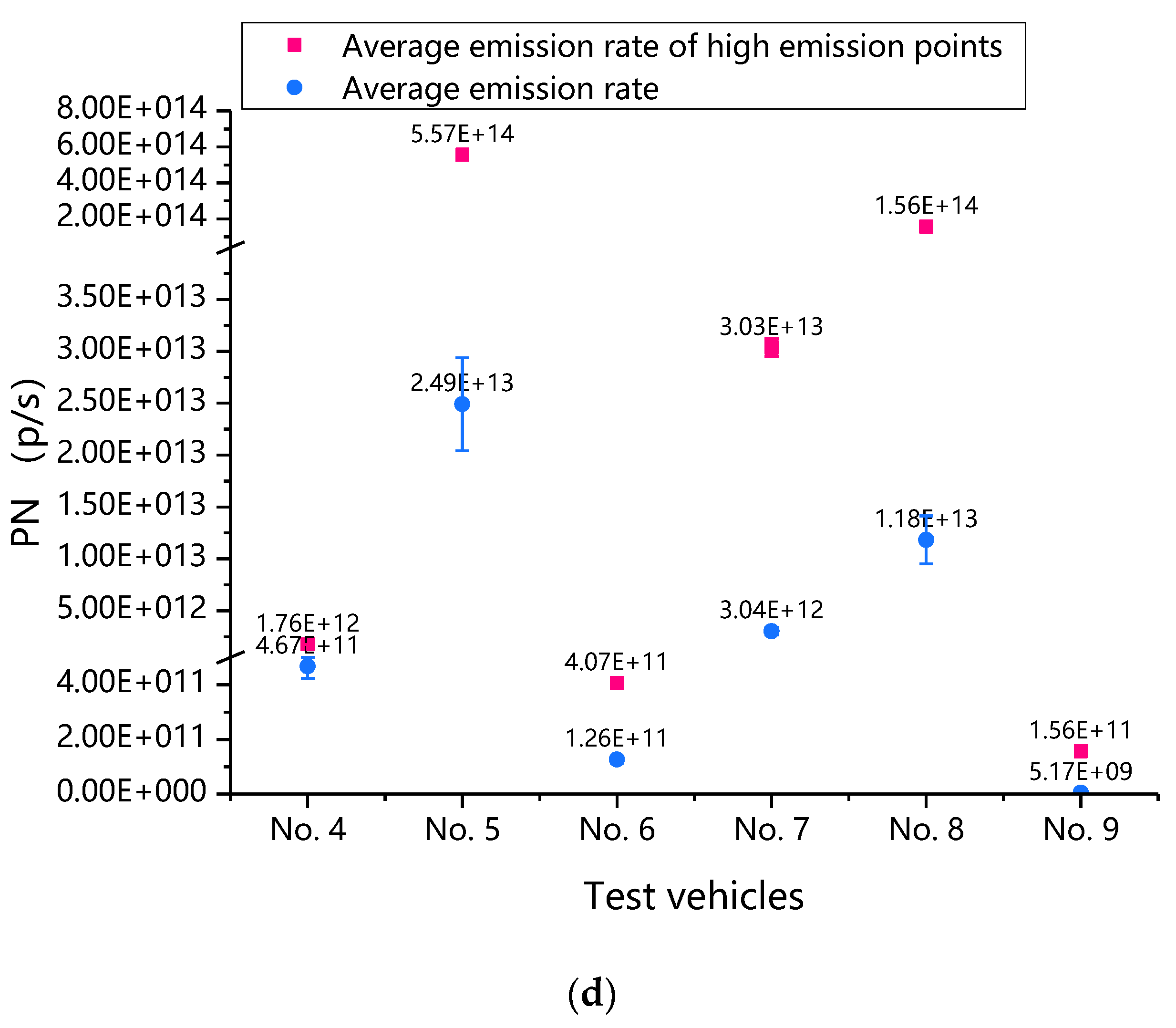
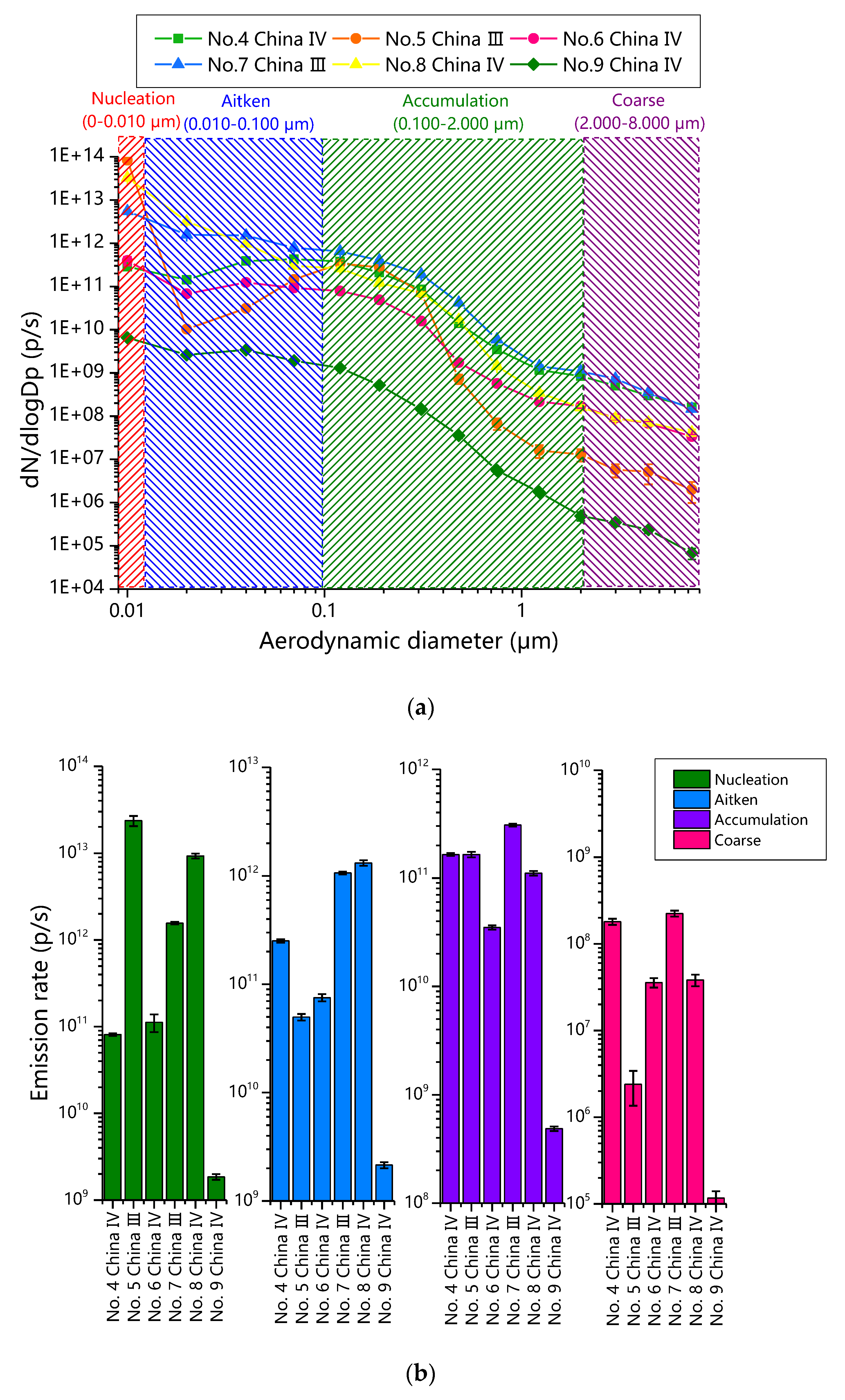
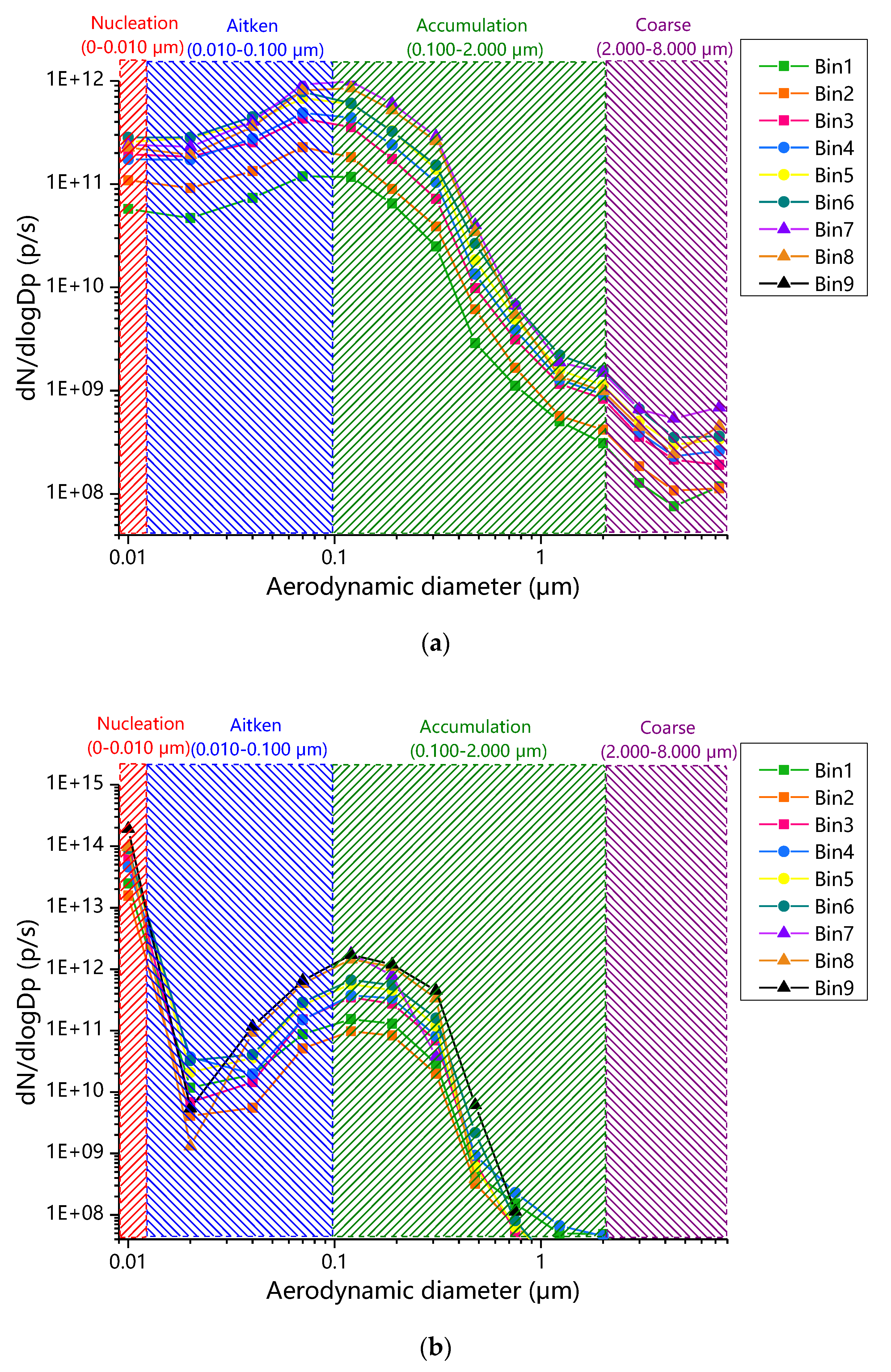
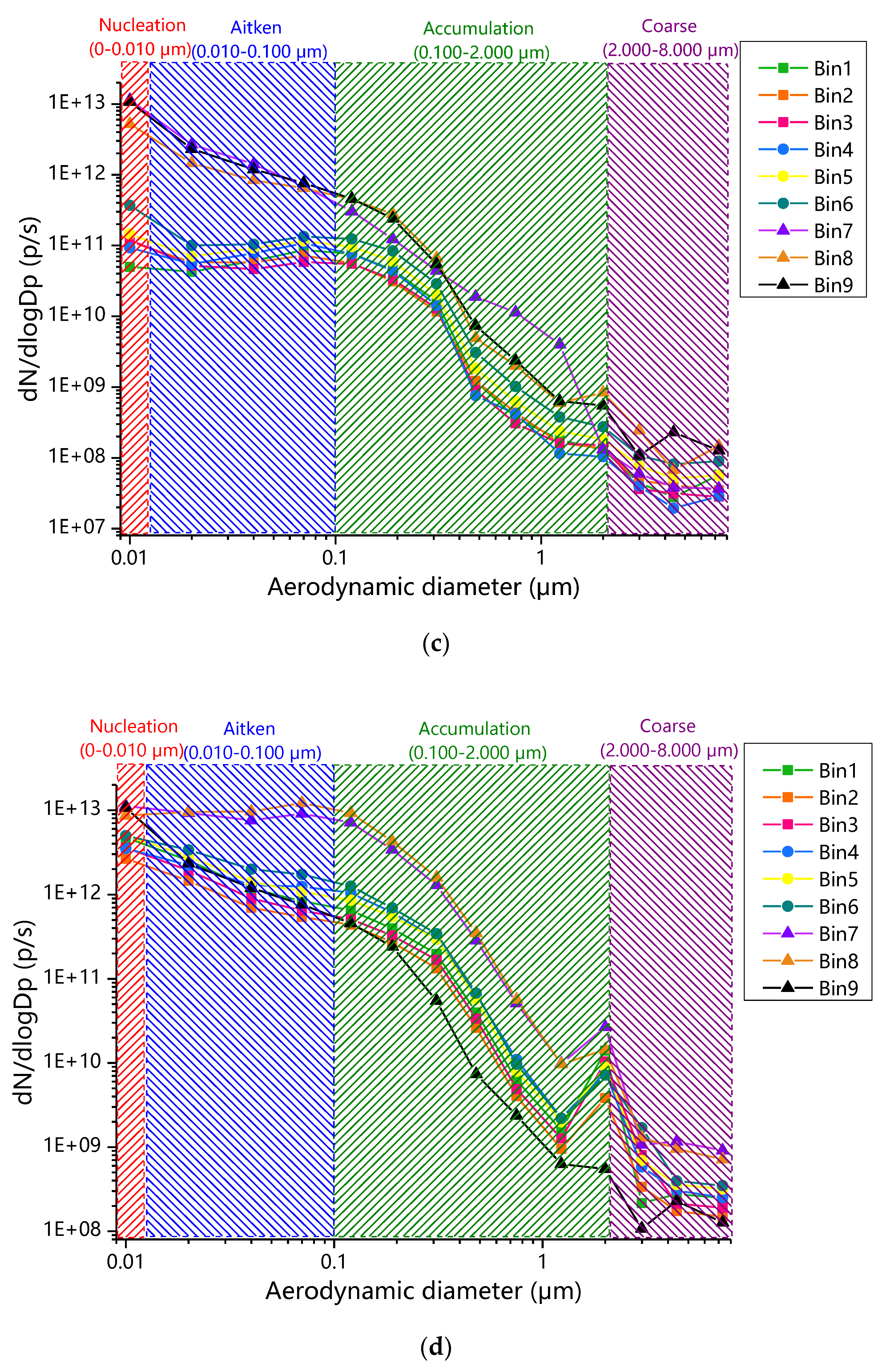
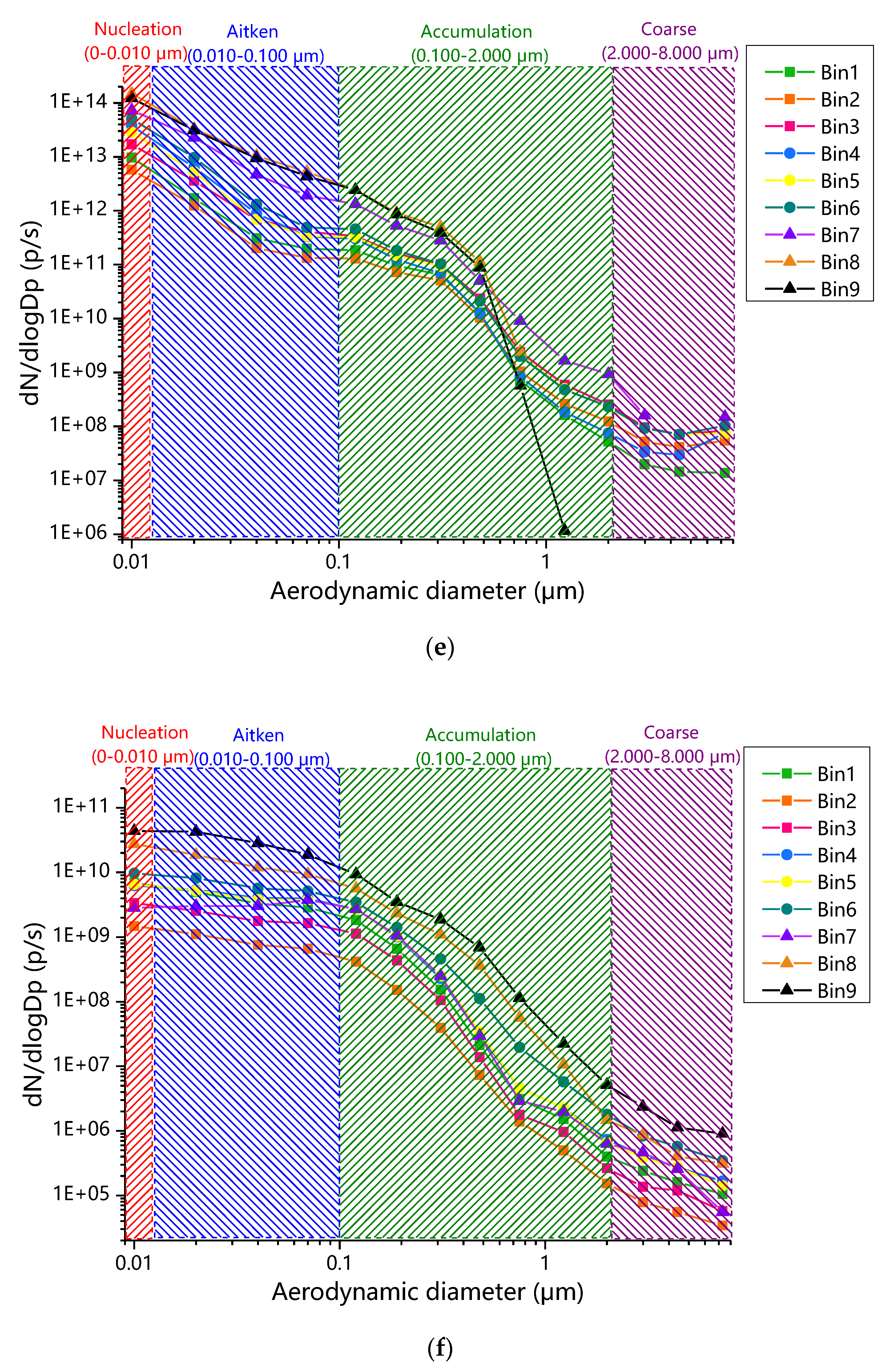
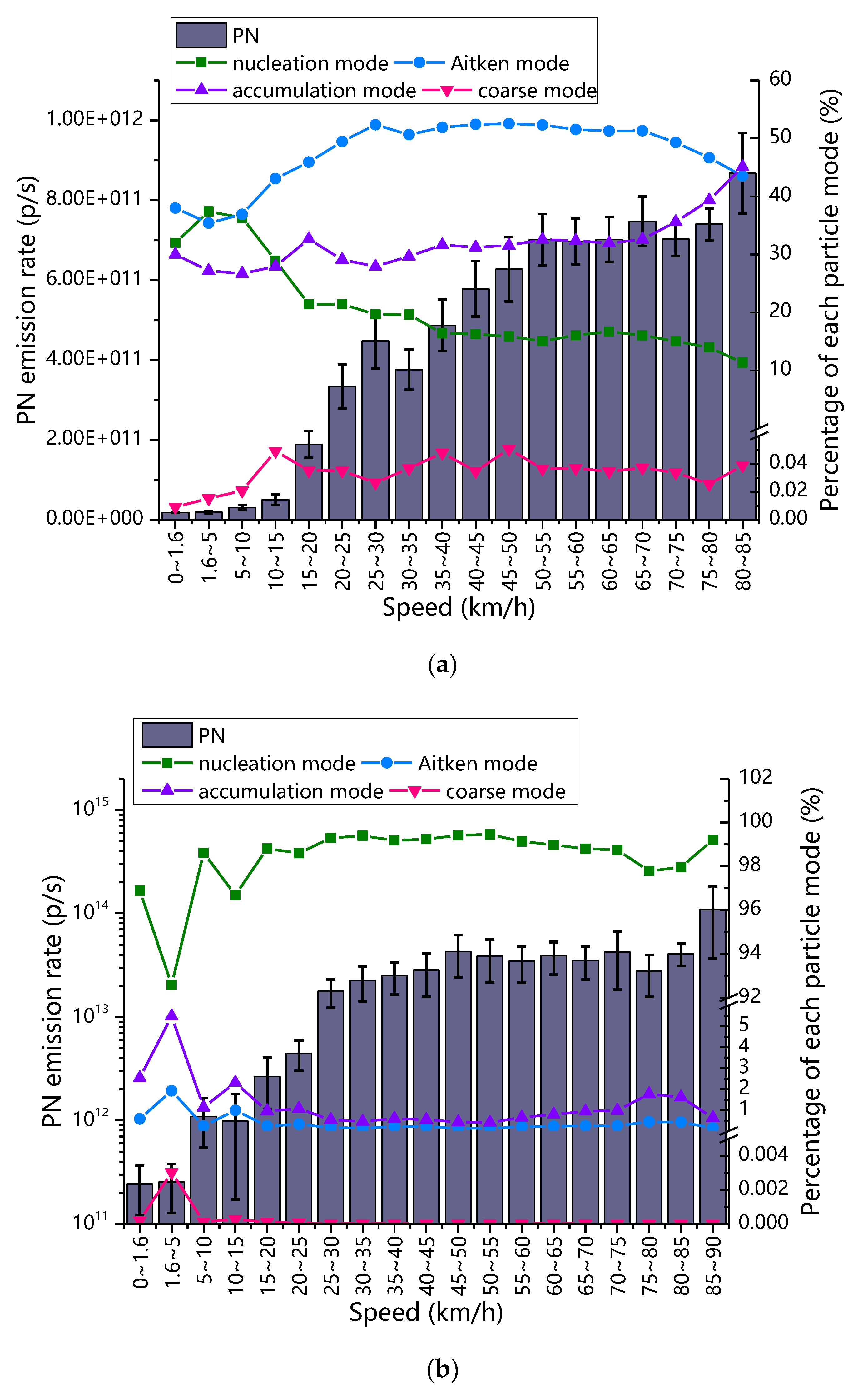
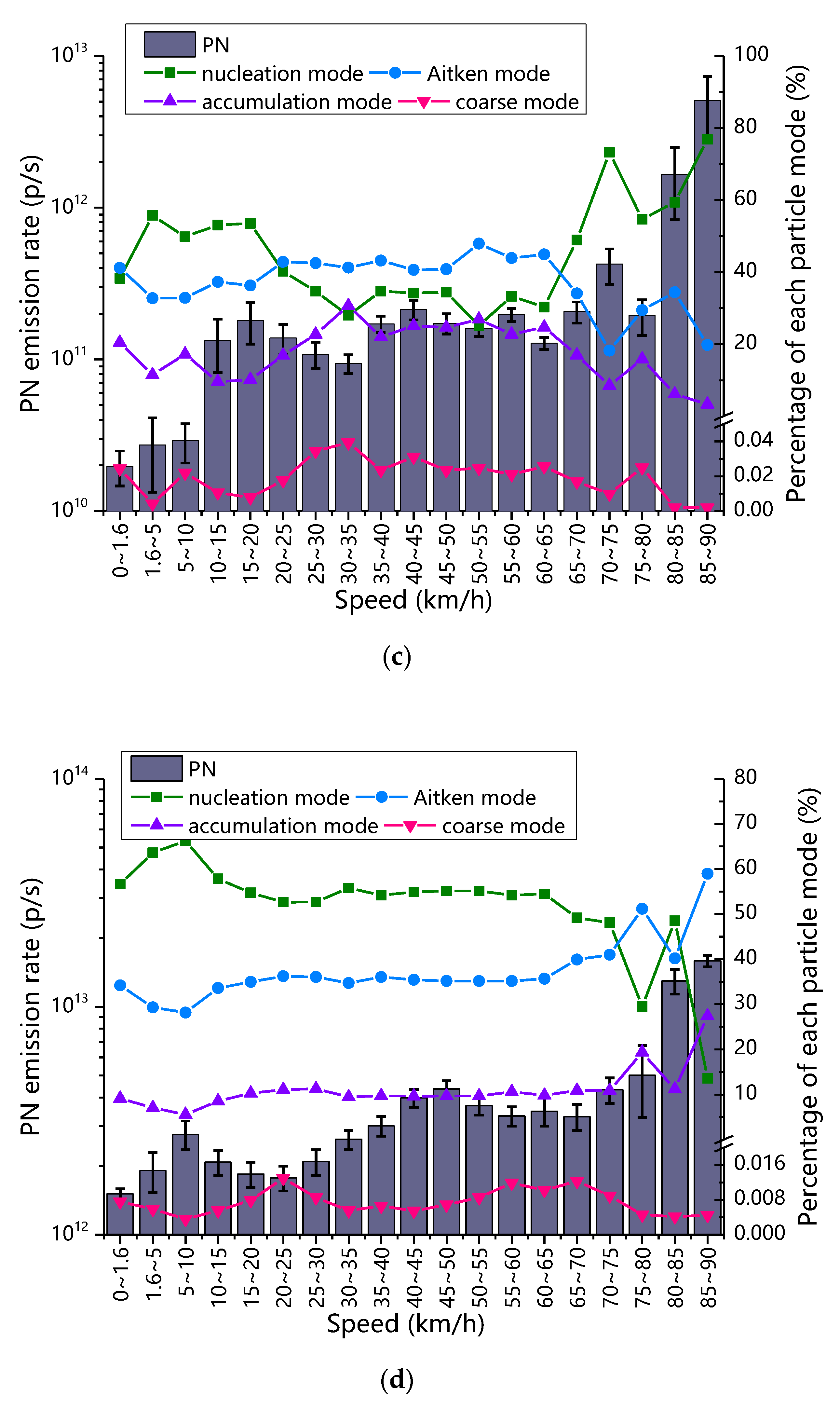
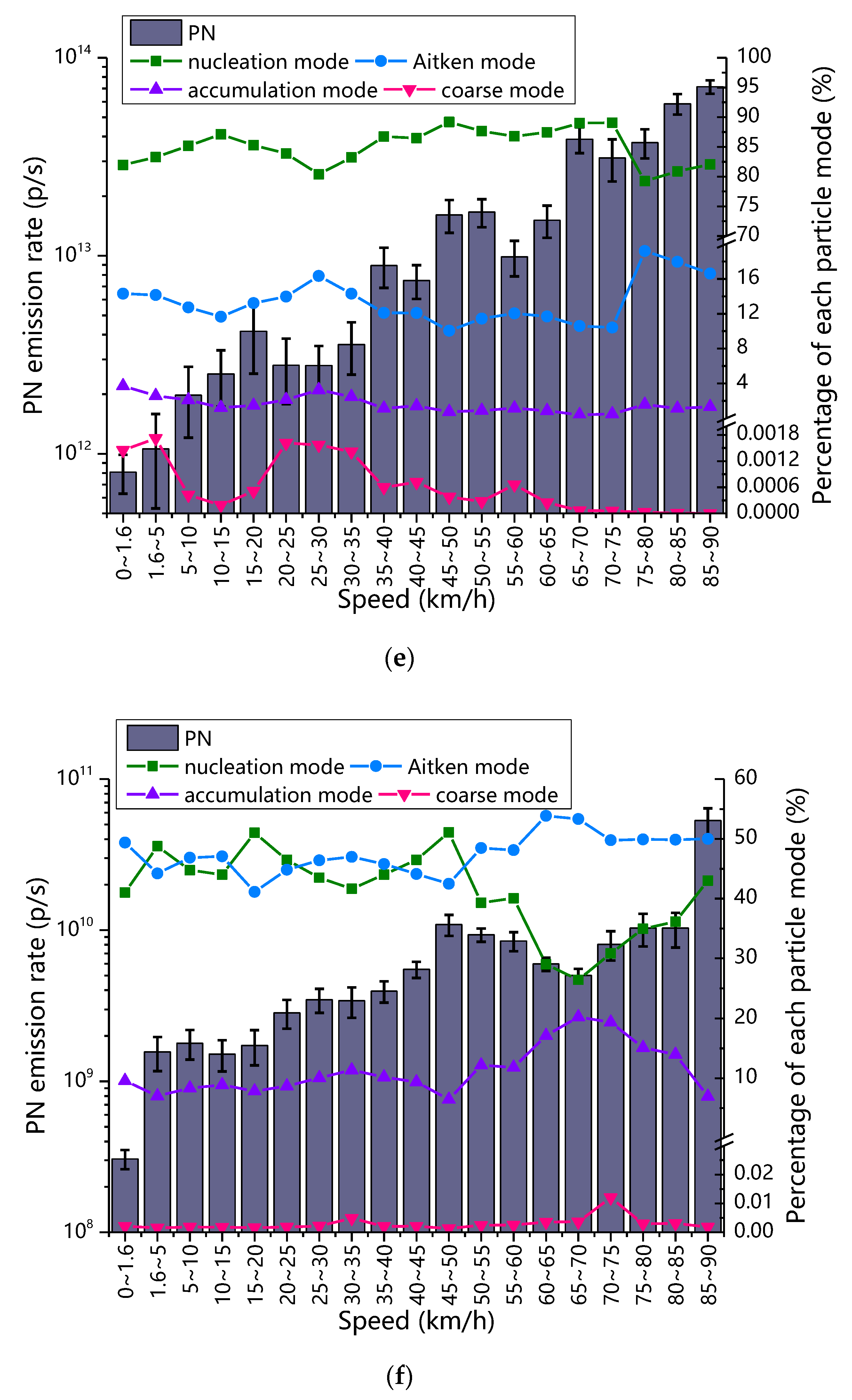
| Test No. | Vehicle Type | Fuel Type | Mode Year | Emission Standard | Mileage (103 km) | Power (kw) | After-Treatment | Curb Weight (kg) |
|---|---|---|---|---|---|---|---|---|
| 1 | Car | Gasoline,92# (China V) | 2011.3 | China IV | 140 | 106 | MPI,TWC | 1610 |
| 2 | Car | 2011.11 | China IV | 50 | 106 | MPI,TWC | 1595 | |
| 3 | Truck | Diesel,0# (China V) | 2014.4 | China III | 120 | 118 | CIC,ECR, | 5800 |
| 4 | Truck | 2015.5 | China IV | 90 | 118 | CIC,ECR,CRT | 5800 | |
| 5 | Middle bus | 2012.11. | China III | 290 | 85 | HPCR | 3450 | |
| 6 | Middle bus | 2014.6 | China IV | 200 | 95 | HPCR,CRT | 4100 | |
| 7 | Bus | 2012.4 | China III | 240 | 180 | CIC,ECR | 10,890 | |
| 8 | Bus | 2016.7 | China IV | 120 | 160 | CIC,CRDI,SCR | 9560 | |
| 9 | Bus | LNG | 2015.1 | China IV | 160 | 187 | CIC | 11,490 |
| Vehicle Type | Emission Standards | Model Year | Mileage (103 km) | Fuel Type | CO | HC | NOx | PM | PN | Source |
|---|---|---|---|---|---|---|---|---|---|---|
| (g/km) | (g/km) | (g/km) | (g/km) | (p/km) | ||||||
| Gasoline car | China IV (No.1) | 2011 | 140 | Gasoline,92# (China V) | 0.68 ± 0.14 | 0.016 ± 0.001 | 0.04 ± 0.009 | N/A | N/A | This study |
| China IV (No.2) | 2011 | 50 | Gasoline,92# (China V) | 0.39 ± 0.05 | 0.014 ± 0.002 | 0.01 ± 0.002 | N/A | N/A | This study | |
| Euro IV | 2008 | 139.7 | Gasoline (Euro V) | 1.77 | 0.12 | 0.09 | 0.004 | N/A | [44] | |
| Euro IV | 2008 | 65.3 | Gasoline (Euro V) | 0.7 | 0.03 | 0.07 | 0.002 | N/A | [44] | |
| Euro IV | 2012 | 48.7 | Gasoline (Euro V) | 0.41 | 0.04 | 0.02 | 0.009 | N/A | [44] | |
| Euro IV | 2008–2010 | N/A | Gasoline (Euro V) | 0.40 ± 0.21 | 0.02 ± 0.01 | 0.05 ± 0.03 | N/A | N/A | [45] | |
| Euro IV | 2009 | 3.3–3.8 | Gasoline,93# (China IV) | 0.59 ± 0.84 | 0.02 ± 0.01 | 0.02 ± 0.01 | 0.004 ± 0.001 | N/A | [46] | |
| China IV | 2011 | 15–90 | Gasoline,93# (China IV) | 0.9 | 0.08 | 0.08 | N/A | N/A | [47] | |
| China IV | 2010–2012 | 195 | Gasoline,92# (China V) | 0.9 ± 0.8 | 0.01 ± 0.00 | 0.03 ± 0.02 | N/A | N/A | [48] | |
| Diesel truck | China III (No.3) | 2014 | 120 | Diesel,0# (China V) | 0.73 ± 0.07 | 0.123 ± 0.003 | 3.88 ± 0.157 | N/A | N/A | This study |
| China IV (No.4) | 2015 | 90 | Diesel,0# (China V) | 0.63 ± 0.05 | 0.038 ± 0.002 | 2.82 ± 0.252 | 1.52 ± 0.030 | (3.91 ± 0.38) × 1013 | This study | |
| Before JE V | 1997 | 111 | Ultra-low sulfur diesel | 1.54 | 0.67 | 3.7 | N/A | N/A | [16] | |
| JE V | 2008 | 5.4 | Ultra-low sulfur diesel | 0.49 | 0.008 | 2.64 | N/A | N/A | [16] | |
| JE V | 2010 | 1.6 | Ultra-low sulfur diesel | 0.98 | 0.07 | 2.49 | N/A | N/A | [16] | |
| Diesel middle bus | China III (No.5) | 2012.11 | 290 | Diesel,0# (China V) | 1.65 ± 0.11 | 0.219 ± 0.012 | 3.43 ± 0.208 | 0.06 ± 0.004 | (2.27 ± 0.41) × 1015 | This study |
| China IV (No.6) | 2014.6 | 200 | Diesel,0# (China V) | 0.46 ± 0.05 | 0.050 ± 0.004 | 2.54 ± 0.172 | 0.03 ± 0.009 | (1.03 ± 0.99) × 1013 | This study | |
| Before JE V | 2003 | 53.9 | Ultra-low sulfur diesel | 1.66 | 0.5 | 8.16 | 0.11 | N/A | [16] | |
| JE V | 2005 | 33.2 | Ultra-low sulfur diesel | 1.46 | 0.37 | 6.45 | 0.055 | N/A | [16] | |
| Diesel bus | China III (No.7) | 2012 | 240 | Diesel,0# (China V) | 5.45 ± 0.88 | 0.225 ± 0.006 | 10.90 ± 0.592 | 0.77 ± 0.108 | (3.40 ± 0.37) × 1014 | This study |
| China IV (No.8) | 2016 | 120 | Diesel,0# (China V) | 3.20 ± 0.69 | 0.067 ± 0.004 | 5.23 ± 0.690 | 0.07 ± 0.016 | (1.13 ± 0.22) × 1015 | This study | |
| Euro III | 2005 | 32 | Ultra-low sulfur diesel | 4.64 | 0.15 | 14.2 | 0.066 | N/A | [16] | |
| Euro III | N/A | 78.3 | Diesel (China III) | 6.7 | 0.14 | 12.1 | 2.955 | N/A | [49] | |
| Euro III | N/A | 81.6 | Diesel (China III) | 4.78 | 0.19 | 12.77 | 3.086 | N/A | [49] | |
| China III | 2008 | 124 | Ultra-low sulfur diesel | 5.97 | 0.09 | 14.1 | 0.053 | N/A | [16] | |
| China IV | 2009 | 72 | Ultra-low sulfur diesel | 4.21 | 0.16 | 17.9 | 0.00045 | N/A | [16] | |
| Euro IV | 2010 | 53.6 | Diesel (Euro IV) | 8.28 | 0.02 | 8.86 | 0.67 | N/A | [31] | |
| Euro IV | N/A | 59.2 | Diesel (China III) | 1.311 | 0.05 | 11.97 | 0.409 | N/A | [49] | |
| Euro IV | N/A | 42.9 | Diesel (China III) | 1.533 | 0.04 | 10.06 | 0.853 | N/A | [49] | |
| LNG bus | China IV (No.9) | 2015 | 160 | LNG | 0.34 ± 0.02 | 5.275 ± 0.421 | 15.63 ± 1.430 | 0.0004 ± 0.00008 | (5.68 ± 0.10) × 1011 | This study |
| Euro IV | N/A | 40.3 | CNG | 4.14 | 0.25 | 3.22 | 0.006 | N/A | [49] | |
| Euro IV | N/A | 39.9 | CNG | 12.72 | 1.01 | 2.95 | 0.218 | N/A | [49] | |
| Euro V | 2012 | N/A | LNG | 1.2 | 1.5 | 3.16 | N/A | N/A | [36] | |
| Euro V | 2012 | N/A | LNG | 0.7 | N/A | 3.3 | N/A | N/A | [36] |
© 2020 by the authors. Licensee MDPI, Basel, Switzerland. This article is an open access article distributed under the terms and conditions of the Creative Commons Attribution (CC BY) license (http://creativecommons.org/licenses/by/4.0/).
Share and Cite
Ma, C.; Wu, L.; Mao, H.-j.; Fang, X.-z.; Wei, N.; Zhang, J.-s.; Yang, Z.-w.; Zhang, Y.-j.; Lv, Z.-y.; Yang, L. Transient Characterization of Automotive Exhaust Emission from Different Vehicle Types Based on On-Road Measurements. Atmosphere 2020, 11, 64. https://doi.org/10.3390/atmos11010064
Ma C, Wu L, Mao H-j, Fang X-z, Wei N, Zhang J-s, Yang Z-w, Zhang Y-j, Lv Z-y, Yang L. Transient Characterization of Automotive Exhaust Emission from Different Vehicle Types Based on On-Road Measurements. Atmosphere. 2020; 11(1):64. https://doi.org/10.3390/atmos11010064
Chicago/Turabian StyleMa, Chao, Lin Wu, Hong-jun Mao, Xiao-zhen Fang, Ning Wei, Jin-sheng Zhang, Zhi-wen Yang, Yan-jie Zhang, Zong-yan Lv, and Lei Yang. 2020. "Transient Characterization of Automotive Exhaust Emission from Different Vehicle Types Based on On-Road Measurements" Atmosphere 11, no. 1: 64. https://doi.org/10.3390/atmos11010064
APA StyleMa, C., Wu, L., Mao, H.-j., Fang, X.-z., Wei, N., Zhang, J.-s., Yang, Z.-w., Zhang, Y.-j., Lv, Z.-y., & Yang, L. (2020). Transient Characterization of Automotive Exhaust Emission from Different Vehicle Types Based on On-Road Measurements. Atmosphere, 11(1), 64. https://doi.org/10.3390/atmos11010064





